Managing Flexible Workforces in Organizations
VerifiedAdded on 2020/06/06
|19
|5080
|74
AI Summary
This assignment delves into the effective management of flexible workforces within organizations. It examines various consultation approaches employees can adopt to address challenges and improve performance. Furthermore, it highlights the importance of integrating flexible employees with organizational culture and goals to foster a cohesive and productive work environment.
Contribute Materials
Your contribution can guide someone’s learning journey. Share your
documents today.
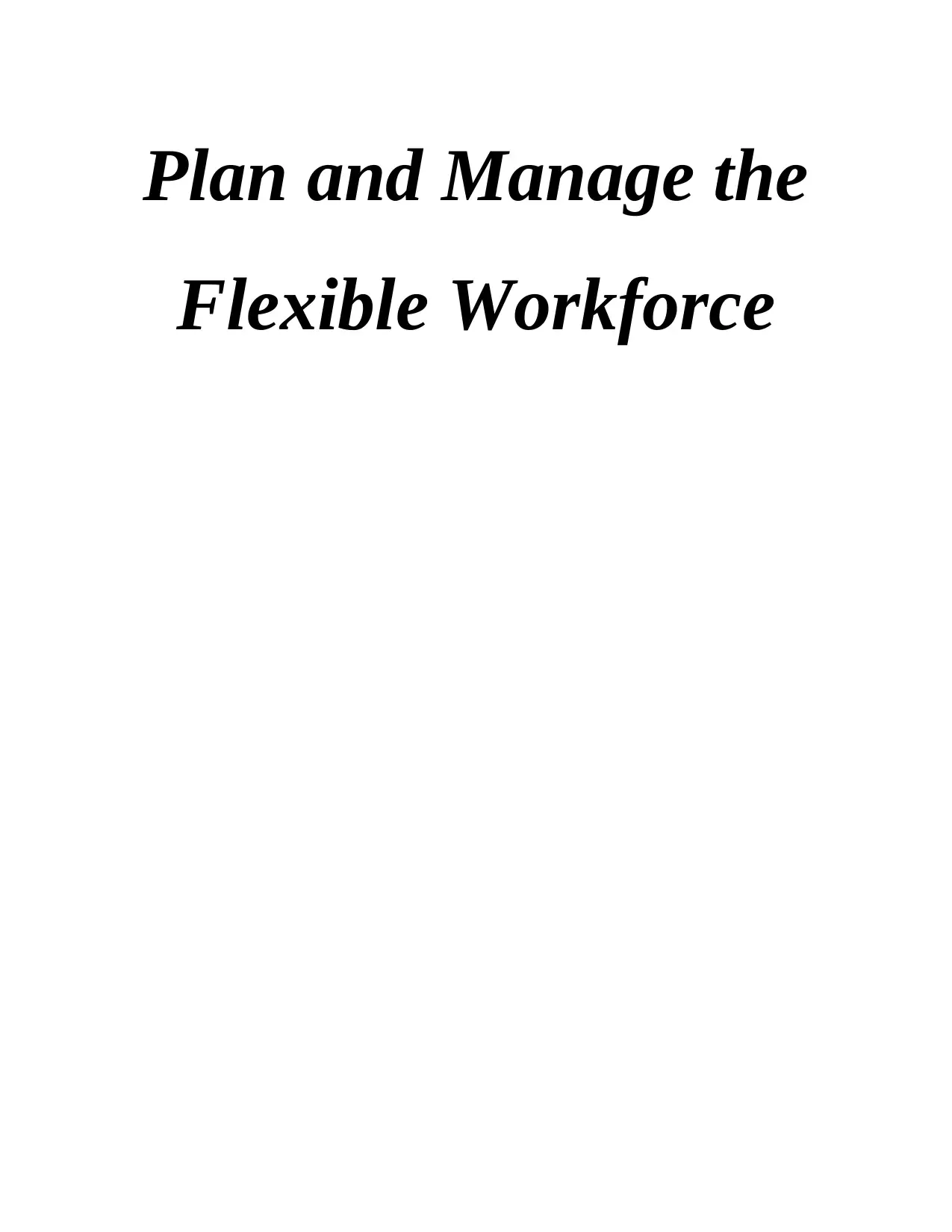
Plan and Manage the
Flexible Workforce
Flexible Workforce
Secure Best Marks with AI Grader
Need help grading? Try our AI Grader for instant feedback on your assignments.
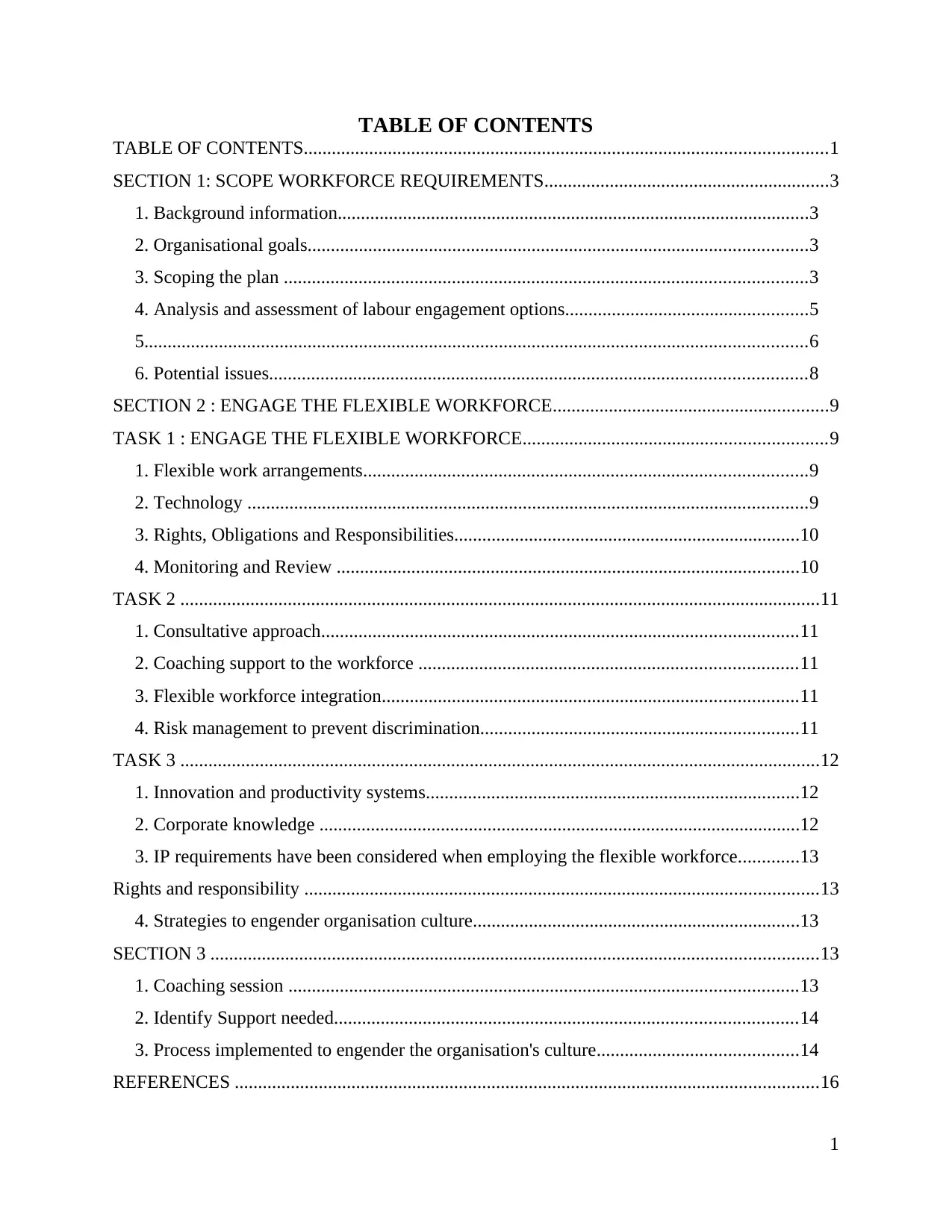
TABLE OF CONTENTS
TABLE OF CONTENTS................................................................................................................1
SECTION 1: SCOPE WORKFORCE REQUIREMENTS.............................................................3
1. Background information.....................................................................................................3
2. Organisational goals...........................................................................................................3
3. Scoping the plan ................................................................................................................3
4. Analysis and assessment of labour engagement options....................................................5
5..............................................................................................................................................6
6. Potential issues...................................................................................................................8
SECTION 2 : ENGAGE THE FLEXIBLE WORKFORCE...........................................................9
TASK 1 : ENGAGE THE FLEXIBLE WORKFORCE.................................................................9
1. Flexible work arrangements...............................................................................................9
2. Technology ........................................................................................................................9
3. Rights, Obligations and Responsibilities..........................................................................10
4. Monitoring and Review ...................................................................................................10
TASK 2 .........................................................................................................................................11
1. Consultative approach......................................................................................................11
2. Coaching support to the workforce .................................................................................11
3. Flexible workforce integration.........................................................................................11
4. Risk management to prevent discrimination....................................................................11
TASK 3 .........................................................................................................................................12
1. Innovation and productivity systems................................................................................12
2. Corporate knowledge .......................................................................................................12
3. IP requirements have been considered when employing the flexible workforce.............13
Rights and responsibility ..............................................................................................................13
4. Strategies to engender organisation culture......................................................................13
SECTION 3 ..................................................................................................................................13
1. Coaching session .............................................................................................................13
2. Identify Support needed...................................................................................................14
3. Process implemented to engender the organisation's culture...........................................14
REFERENCES .............................................................................................................................16
1
TABLE OF CONTENTS................................................................................................................1
SECTION 1: SCOPE WORKFORCE REQUIREMENTS.............................................................3
1. Background information.....................................................................................................3
2. Organisational goals...........................................................................................................3
3. Scoping the plan ................................................................................................................3
4. Analysis and assessment of labour engagement options....................................................5
5..............................................................................................................................................6
6. Potential issues...................................................................................................................8
SECTION 2 : ENGAGE THE FLEXIBLE WORKFORCE...........................................................9
TASK 1 : ENGAGE THE FLEXIBLE WORKFORCE.................................................................9
1. Flexible work arrangements...............................................................................................9
2. Technology ........................................................................................................................9
3. Rights, Obligations and Responsibilities..........................................................................10
4. Monitoring and Review ...................................................................................................10
TASK 2 .........................................................................................................................................11
1. Consultative approach......................................................................................................11
2. Coaching support to the workforce .................................................................................11
3. Flexible workforce integration.........................................................................................11
4. Risk management to prevent discrimination....................................................................11
TASK 3 .........................................................................................................................................12
1. Innovation and productivity systems................................................................................12
2. Corporate knowledge .......................................................................................................12
3. IP requirements have been considered when employing the flexible workforce.............13
Rights and responsibility ..............................................................................................................13
4. Strategies to engender organisation culture......................................................................13
SECTION 3 ..................................................................................................................................13
1. Coaching session .............................................................................................................13
2. Identify Support needed...................................................................................................14
3. Process implemented to engender the organisation's culture...........................................14
REFERENCES .............................................................................................................................16
1
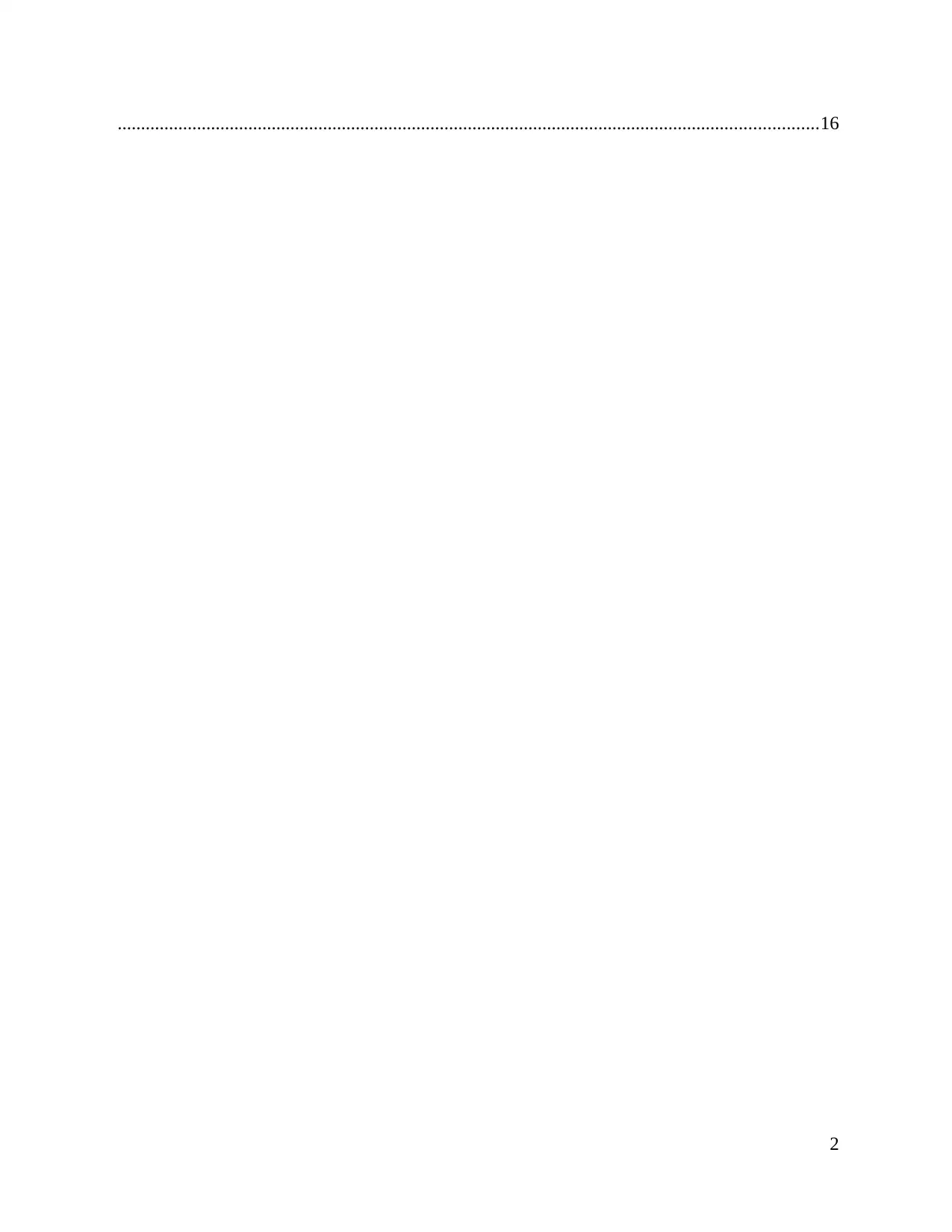
......................................................................................................................................................16
2
2
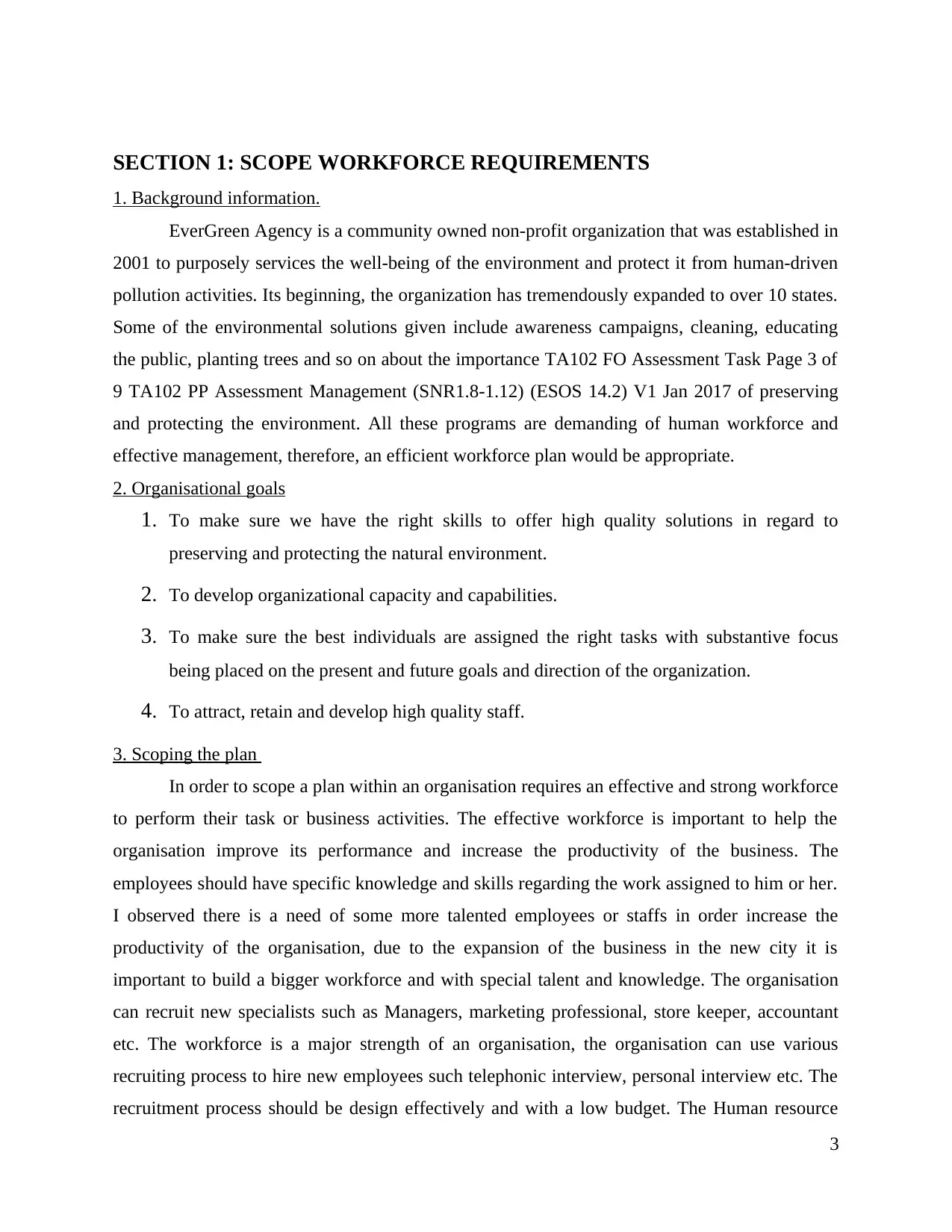
SECTION 1: SCOPE WORKFORCE REQUIREMENTS
1. Background information.
EverGreen Agency is a community owned non-profit organization that was established in
2001 to purposely services the well-being of the environment and protect it from human-driven
pollution activities. Its beginning, the organization has tremendously expanded to over 10 states.
Some of the environmental solutions given include awareness campaigns, cleaning, educating
the public, planting trees and so on about the importance TA102 FO Assessment Task Page 3 of
9 TA102 PP Assessment Management (SNR1.8-1.12) (ESOS 14.2) V1 Jan 2017 of preserving
and protecting the environment. All these programs are demanding of human workforce and
effective management, therefore, an efficient workforce plan would be appropriate.
2. Organisational goals
1. To make sure we have the right skills to offer high quality solutions in regard to
preserving and protecting the natural environment.
2. To develop organizational capacity and capabilities.
3. To make sure the best individuals are assigned the right tasks with substantive focus
being placed on the present and future goals and direction of the organization.
4. To attract, retain and develop high quality staff.
3. Scoping the plan
In order to scope a plan within an organisation requires an effective and strong workforce
to perform their task or business activities. The effective workforce is important to help the
organisation improve its performance and increase the productivity of the business. The
employees should have specific knowledge and skills regarding the work assigned to him or her.
I observed there is a need of some more talented employees or staffs in order increase the
productivity of the organisation, due to the expansion of the business in the new city it is
important to build a bigger workforce and with special talent and knowledge. The organisation
can recruit new specialists such as Managers, marketing professional, store keeper, accountant
etc. The workforce is a major strength of an organisation, the organisation can use various
recruiting process to hire new employees such telephonic interview, personal interview etc. The
recruitment process should be design effectively and with a low budget. The Human resource
3
1. Background information.
EverGreen Agency is a community owned non-profit organization that was established in
2001 to purposely services the well-being of the environment and protect it from human-driven
pollution activities. Its beginning, the organization has tremendously expanded to over 10 states.
Some of the environmental solutions given include awareness campaigns, cleaning, educating
the public, planting trees and so on about the importance TA102 FO Assessment Task Page 3 of
9 TA102 PP Assessment Management (SNR1.8-1.12) (ESOS 14.2) V1 Jan 2017 of preserving
and protecting the environment. All these programs are demanding of human workforce and
effective management, therefore, an efficient workforce plan would be appropriate.
2. Organisational goals
1. To make sure we have the right skills to offer high quality solutions in regard to
preserving and protecting the natural environment.
2. To develop organizational capacity and capabilities.
3. To make sure the best individuals are assigned the right tasks with substantive focus
being placed on the present and future goals and direction of the organization.
4. To attract, retain and develop high quality staff.
3. Scoping the plan
In order to scope a plan within an organisation requires an effective and strong workforce
to perform their task or business activities. The effective workforce is important to help the
organisation improve its performance and increase the productivity of the business. The
employees should have specific knowledge and skills regarding the work assigned to him or her.
I observed there is a need of some more talented employees or staffs in order increase the
productivity of the organisation, due to the expansion of the business in the new city it is
important to build a bigger workforce and with special talent and knowledge. The organisation
can recruit new specialists such as Managers, marketing professional, store keeper, accountant
etc. The workforce is a major strength of an organisation, the organisation can use various
recruiting process to hire new employees such telephonic interview, personal interview etc. The
recruitment process should be design effectively and with a low budget. The Human resource
3
Secure Best Marks with AI Grader
Need help grading? Try our AI Grader for instant feedback on your assignments.
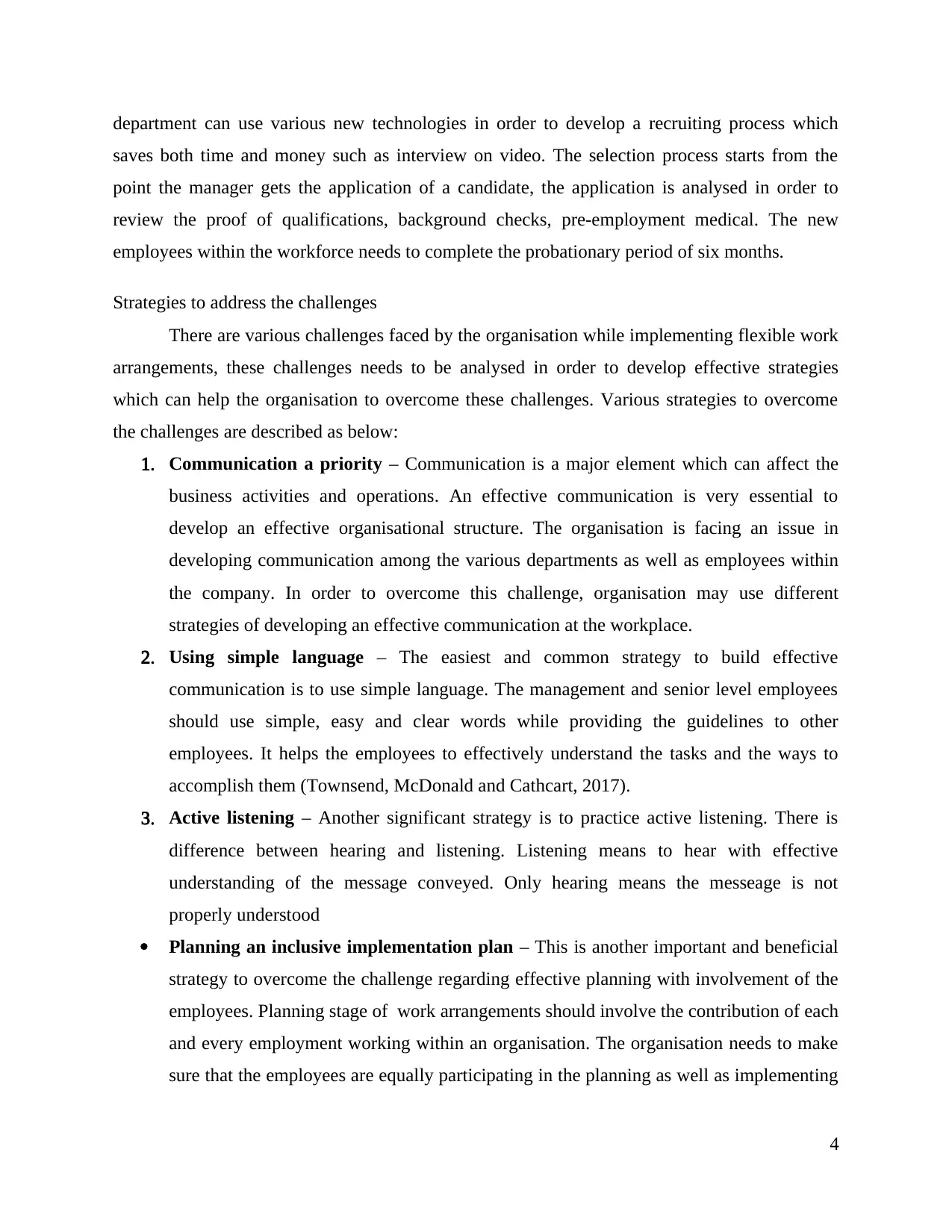
department can use various new technologies in order to develop a recruiting process which
saves both time and money such as interview on video. The selection process starts from the
point the manager gets the application of a candidate, the application is analysed in order to
review the proof of qualifications, background checks, pre-employment medical. The new
employees within the workforce needs to complete the probationary period of six months.
Strategies to address the challenges
There are various challenges faced by the organisation while implementing flexible work
arrangements, these challenges needs to be analysed in order to develop effective strategies
which can help the organisation to overcome these challenges. Various strategies to overcome
the challenges are described as below:
1. Communication a priority – Communication is a major element which can affect the
business activities and operations. An effective communication is very essential to
develop an effective organisational structure. The organisation is facing an issue in
developing communication among the various departments as well as employees within
the company. In order to overcome this challenge, organisation may use different
strategies of developing an effective communication at the workplace.
2. Using simple language – The easiest and common strategy to build effective
communication is to use simple language. The management and senior level employees
should use simple, easy and clear words while providing the guidelines to other
employees. It helps the employees to effectively understand the tasks and the ways to
accomplish them (Townsend, McDonald and Cathcart, 2017).
3. Active listening – Another significant strategy is to practice active listening. There is
difference between hearing and listening. Listening means to hear with effective
understanding of the message conveyed. Only hearing means the messeage is not
properly understood
Planning an inclusive implementation plan – This is another important and beneficial
strategy to overcome the challenge regarding effective planning with involvement of the
employees. Planning stage of work arrangements should involve the contribution of each
and every employment working within an organisation. The organisation needs to make
sure that the employees are equally participating in the planning as well as implementing
4
saves both time and money such as interview on video. The selection process starts from the
point the manager gets the application of a candidate, the application is analysed in order to
review the proof of qualifications, background checks, pre-employment medical. The new
employees within the workforce needs to complete the probationary period of six months.
Strategies to address the challenges
There are various challenges faced by the organisation while implementing flexible work
arrangements, these challenges needs to be analysed in order to develop effective strategies
which can help the organisation to overcome these challenges. Various strategies to overcome
the challenges are described as below:
1. Communication a priority – Communication is a major element which can affect the
business activities and operations. An effective communication is very essential to
develop an effective organisational structure. The organisation is facing an issue in
developing communication among the various departments as well as employees within
the company. In order to overcome this challenge, organisation may use different
strategies of developing an effective communication at the workplace.
2. Using simple language – The easiest and common strategy to build effective
communication is to use simple language. The management and senior level employees
should use simple, easy and clear words while providing the guidelines to other
employees. It helps the employees to effectively understand the tasks and the ways to
accomplish them (Townsend, McDonald and Cathcart, 2017).
3. Active listening – Another significant strategy is to practice active listening. There is
difference between hearing and listening. Listening means to hear with effective
understanding of the message conveyed. Only hearing means the messeage is not
properly understood
Planning an inclusive implementation plan – This is another important and beneficial
strategy to overcome the challenge regarding effective planning with involvement of the
employees. Planning stage of work arrangements should involve the contribution of each
and every employment working within an organisation. The organisation needs to make
sure that the employees are equally participating in the planning as well as implementing
4
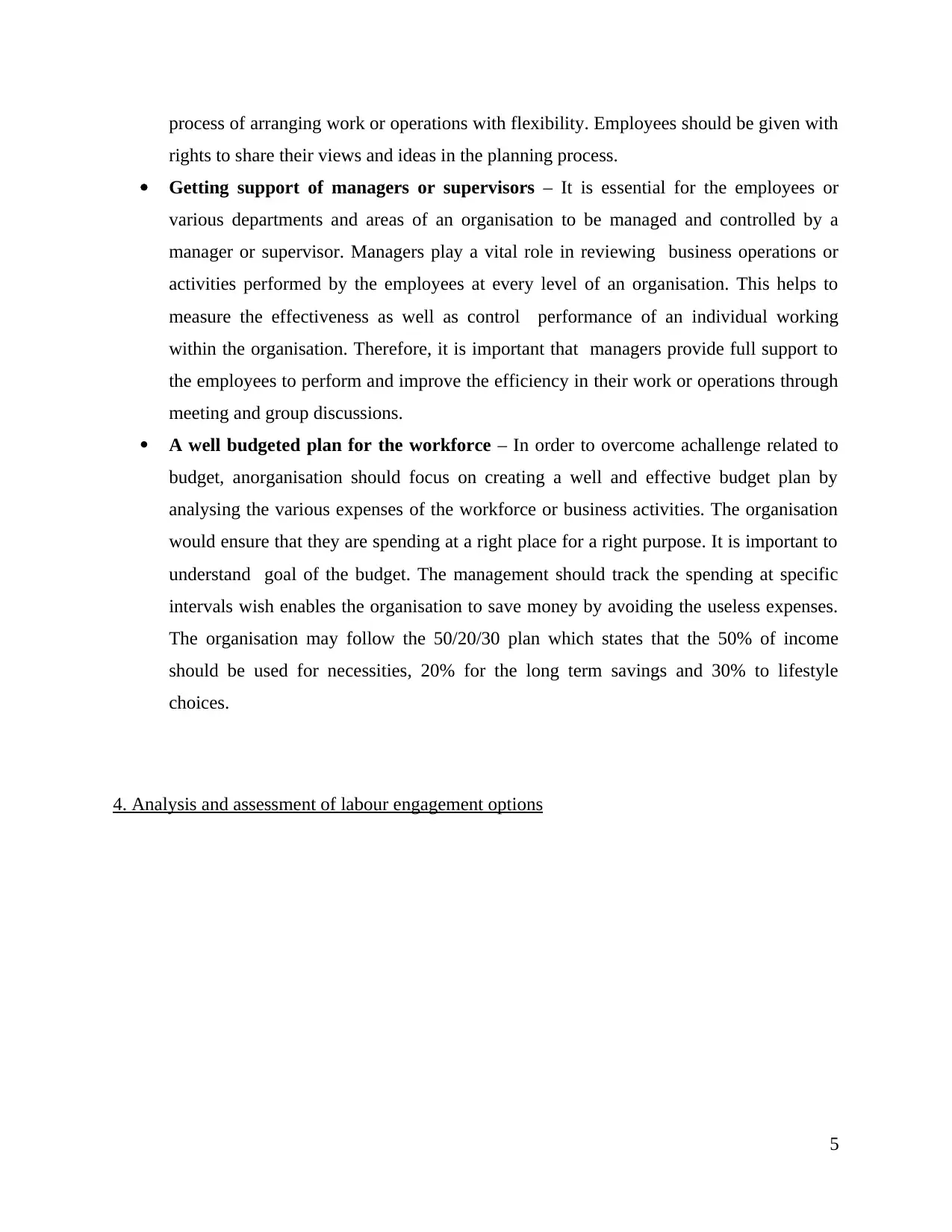
process of arranging work or operations with flexibility. Employees should be given with
rights to share their views and ideas in the planning process.
Getting support of managers or supervisors – It is essential for the employees or
various departments and areas of an organisation to be managed and controlled by a
manager or supervisor. Managers play a vital role in reviewing business operations or
activities performed by the employees at every level of an organisation. This helps to
measure the effectiveness as well as control performance of an individual working
within the organisation. Therefore, it is important that managers provide full support to
the employees to perform and improve the efficiency in their work or operations through
meeting and group discussions.
A well budgeted plan for the workforce – In order to overcome achallenge related to
budget, anorganisation should focus on creating a well and effective budget plan by
analysing the various expenses of the workforce or business activities. The organisation
would ensure that they are spending at a right place for a right purpose. It is important to
understand goal of the budget. The management should track the spending at specific
intervals wish enables the organisation to save money by avoiding the useless expenses.
The organisation may follow the 50/20/30 plan which states that the 50% of income
should be used for necessities, 20% for the long term savings and 30% to lifestyle
choices.
4. Analysis and assessment of labour engagement options
5
rights to share their views and ideas in the planning process.
Getting support of managers or supervisors – It is essential for the employees or
various departments and areas of an organisation to be managed and controlled by a
manager or supervisor. Managers play a vital role in reviewing business operations or
activities performed by the employees at every level of an organisation. This helps to
measure the effectiveness as well as control performance of an individual working
within the organisation. Therefore, it is important that managers provide full support to
the employees to perform and improve the efficiency in their work or operations through
meeting and group discussions.
A well budgeted plan for the workforce – In order to overcome achallenge related to
budget, anorganisation should focus on creating a well and effective budget plan by
analysing the various expenses of the workforce or business activities. The organisation
would ensure that they are spending at a right place for a right purpose. It is important to
understand goal of the budget. The management should track the spending at specific
intervals wish enables the organisation to save money by avoiding the useless expenses.
The organisation may follow the 50/20/30 plan which states that the 50% of income
should be used for necessities, 20% for the long term savings and 30% to lifestyle
choices.
4. Analysis and assessment of labour engagement options
5
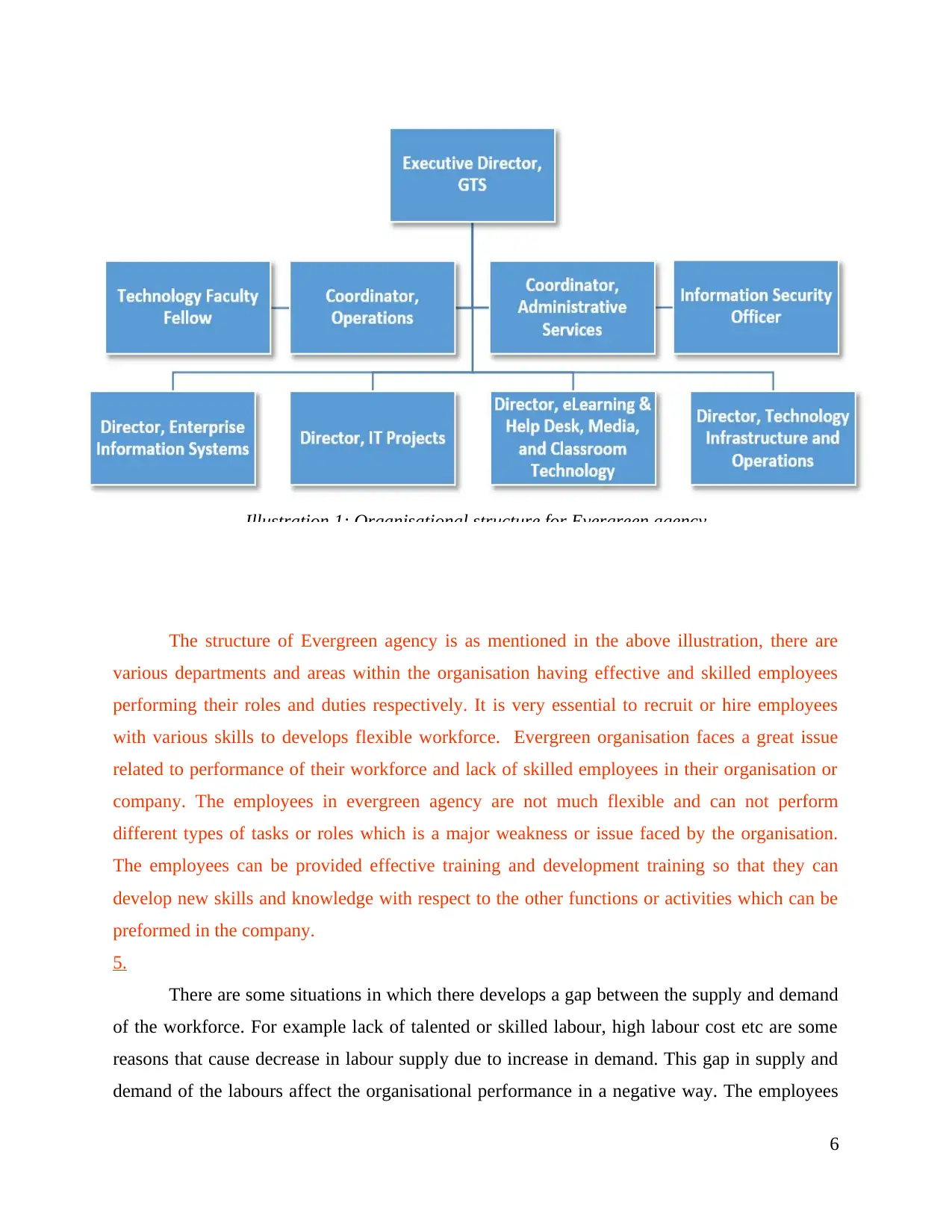
The structure of Evergreen agency is as mentioned in the above illustration, there are
various departments and areas within the organisation having effective and skilled employees
performing their roles and duties respectively. It is very essential to recruit or hire employees
with various skills to develops flexible workforce. Evergreen organisation faces a great issue
related to performance of their workforce and lack of skilled employees in their organisation or
company. The employees in evergreen agency are not much flexible and can not perform
different types of tasks or roles which is a major weakness or issue faced by the organisation.
The employees can be provided effective training and development training so that they can
develop new skills and knowledge with respect to the other functions or activities which can be
preformed in the company.
5.
There are some situations in which there develops a gap between the supply and demand
of the workforce. For example lack of talented or skilled labour, high labour cost etc are some
reasons that cause decrease in labour supply due to increase in demand. This gap in supply and
demand of the labours affect the organisational performance in a negative way. The employees
6
Illustration 1: Organisational structure for Evergreen agency
various departments and areas within the organisation having effective and skilled employees
performing their roles and duties respectively. It is very essential to recruit or hire employees
with various skills to develops flexible workforce. Evergreen organisation faces a great issue
related to performance of their workforce and lack of skilled employees in their organisation or
company. The employees in evergreen agency are not much flexible and can not perform
different types of tasks or roles which is a major weakness or issue faced by the organisation.
The employees can be provided effective training and development training so that they can
develop new skills and knowledge with respect to the other functions or activities which can be
preformed in the company.
5.
There are some situations in which there develops a gap between the supply and demand
of the workforce. For example lack of talented or skilled labour, high labour cost etc are some
reasons that cause decrease in labour supply due to increase in demand. This gap in supply and
demand of the labours affect the organisational performance in a negative way. The employees
6
Illustration 1: Organisational structure for Evergreen agency
Paraphrase This Document
Need a fresh take? Get an instant paraphrase of this document with our AI Paraphraser
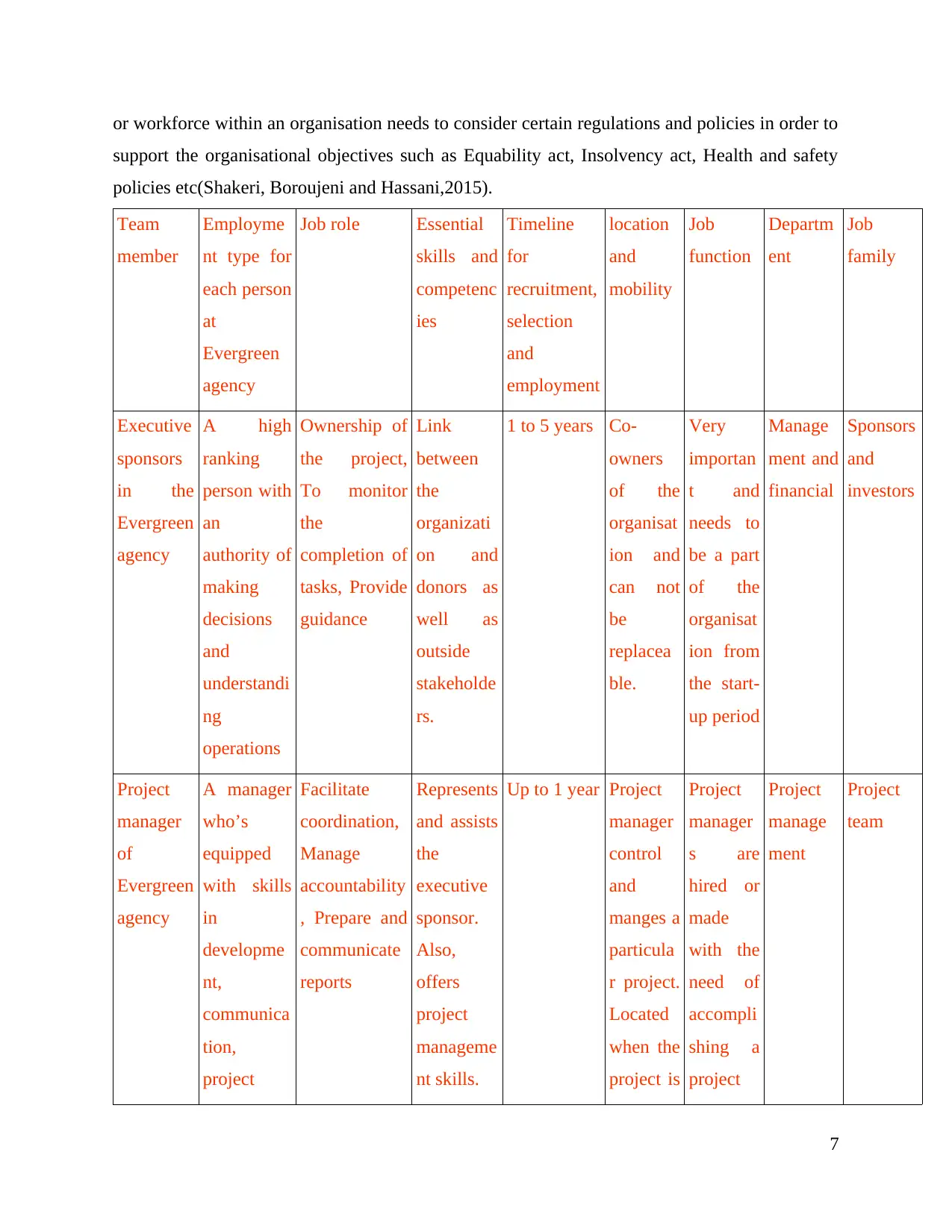
or workforce within an organisation needs to consider certain regulations and policies in order to
support the organisational objectives such as Equability act, Insolvency act, Health and safety
policies etc(Shakeri, Boroujeni and Hassani,2015).
Team
member
Employme
nt type for
each person
at
Evergreen
agency
Job role Essential
skills and
competenc
ies
Timeline
for
recruitment,
selection
and
employment
location
and
mobility
Job
function
Departm
ent
Job
family
Executive
sponsors
in the
Evergreen
agency
A high
ranking
person with
an
authority of
making
decisions
and
understandi
ng
operations
Ownership of
the project,
To monitor
the
completion of
tasks, Provide
guidance
Link
between
the
organizati
on and
donors as
well as
outside
stakeholde
rs.
1 to 5 years Co-
owners
of the
organisat
ion and
can not
be
replacea
ble.
Very
importan
t and
needs to
be a part
of the
organisat
ion from
the start-
up period
Manage
ment and
financial
Sponsors
and
investors
Project
manager
of
Evergreen
agency
A manager
who’s
equipped
with skills
in
developme
nt,
communica
tion,
project
Facilitate
coordination,
Manage
accountability
, Prepare and
communicate
reports
Represents
and assists
the
executive
sponsor.
Also,
offers
project
manageme
nt skills.
Up to 1 year Project
manager
control
and
manges a
particula
r project.
Located
when the
project is
Project
manager
s are
hired or
made
with the
need of
accompli
shing a
project
Project
manage
ment
Project
team
7
support the organisational objectives such as Equability act, Insolvency act, Health and safety
policies etc(Shakeri, Boroujeni and Hassani,2015).
Team
member
Employme
nt type for
each person
at
Evergreen
agency
Job role Essential
skills and
competenc
ies
Timeline
for
recruitment,
selection
and
employment
location
and
mobility
Job
function
Departm
ent
Job
family
Executive
sponsors
in the
Evergreen
agency
A high
ranking
person with
an
authority of
making
decisions
and
understandi
ng
operations
Ownership of
the project,
To monitor
the
completion of
tasks, Provide
guidance
Link
between
the
organizati
on and
donors as
well as
outside
stakeholde
rs.
1 to 5 years Co-
owners
of the
organisat
ion and
can not
be
replacea
ble.
Very
importan
t and
needs to
be a part
of the
organisat
ion from
the start-
up period
Manage
ment and
financial
Sponsors
and
investors
Project
manager
of
Evergreen
agency
A manager
who’s
equipped
with skills
in
developme
nt,
communica
tion,
project
Facilitate
coordination,
Manage
accountability
, Prepare and
communicate
reports
Represents
and assists
the
executive
sponsor.
Also,
offers
project
manageme
nt skills.
Up to 1 year Project
manager
control
and
manges a
particula
r project.
Located
when the
project is
Project
manager
s are
hired or
made
with the
need of
accompli
shing a
project
Project
manage
ment
Project
team
7
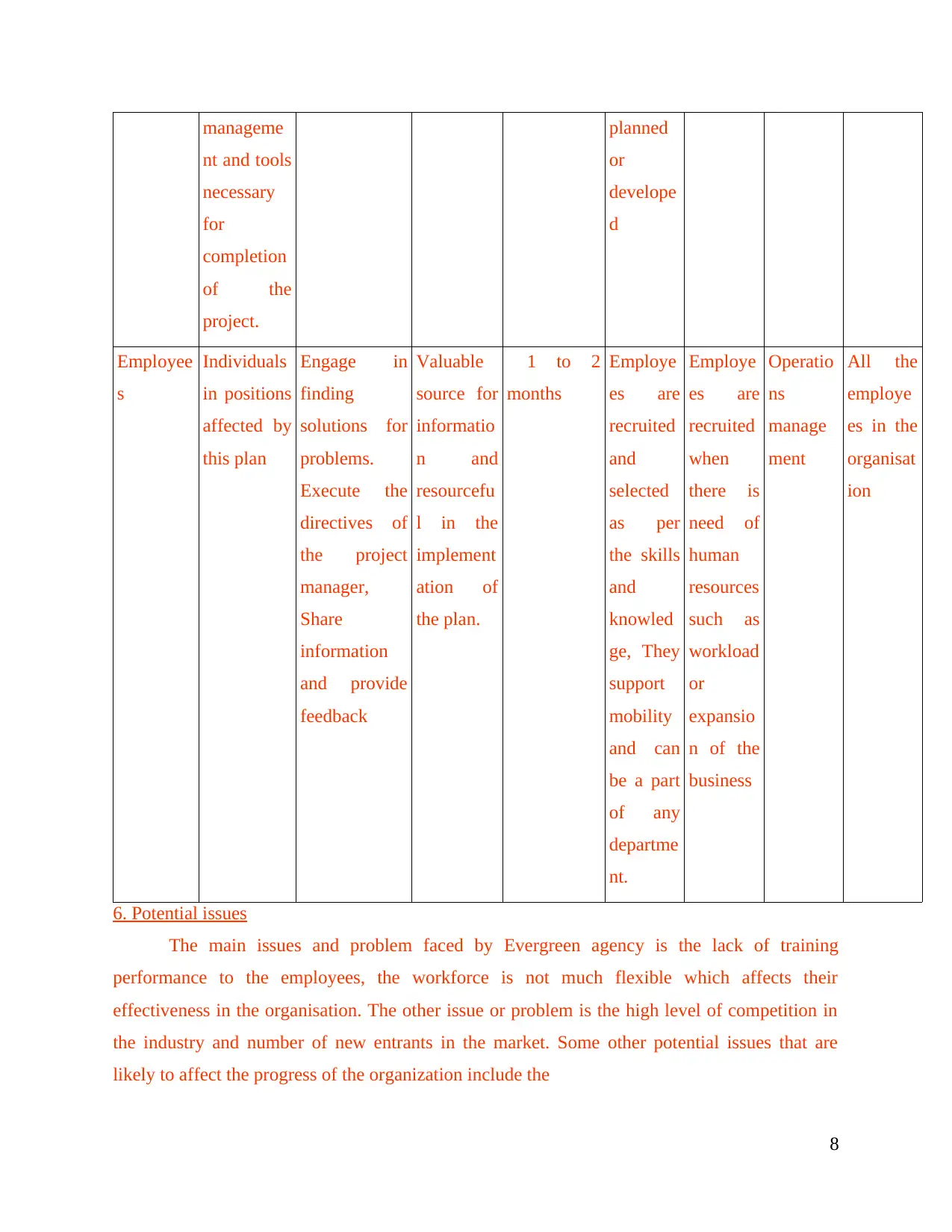
manageme
nt and tools
necessary
for
completion
of the
project.
planned
or
develope
d
Employee
s
Individuals
in positions
affected by
this plan
Engage in
finding
solutions for
problems.
Execute the
directives of
the project
manager,
Share
information
and provide
feedback
Valuable
source for
informatio
n and
resourcefu
l in the
implement
ation of
the plan.
1 to 2
months
Employe
es are
recruited
and
selected
as per
the skills
and
knowled
ge, They
support
mobility
and can
be a part
of any
departme
nt.
Employe
es are
recruited
when
there is
need of
human
resources
such as
workload
or
expansio
n of the
business
Operatio
ns
manage
ment
All the
employe
es in the
organisat
ion
6. Potential issues
The main issues and problem faced by Evergreen agency is the lack of training
performance to the employees, the workforce is not much flexible which affects their
effectiveness in the organisation. The other issue or problem is the high level of competition in
the industry and number of new entrants in the market. Some other potential issues that are
likely to affect the progress of the organization include the
8
nt and tools
necessary
for
completion
of the
project.
planned
or
develope
d
Employee
s
Individuals
in positions
affected by
this plan
Engage in
finding
solutions for
problems.
Execute the
directives of
the project
manager,
Share
information
and provide
feedback
Valuable
source for
informatio
n and
resourcefu
l in the
implement
ation of
the plan.
1 to 2
months
Employe
es are
recruited
and
selected
as per
the skills
and
knowled
ge, They
support
mobility
and can
be a part
of any
departme
nt.
Employe
es are
recruited
when
there is
need of
human
resources
such as
workload
or
expansio
n of the
business
Operatio
ns
manage
ment
All the
employe
es in the
organisat
ion
6. Potential issues
The main issues and problem faced by Evergreen agency is the lack of training
performance to the employees, the workforce is not much flexible which affects their
effectiveness in the organisation. The other issue or problem is the high level of competition in
the industry and number of new entrants in the market. Some other potential issues that are
likely to affect the progress of the organization include the
8
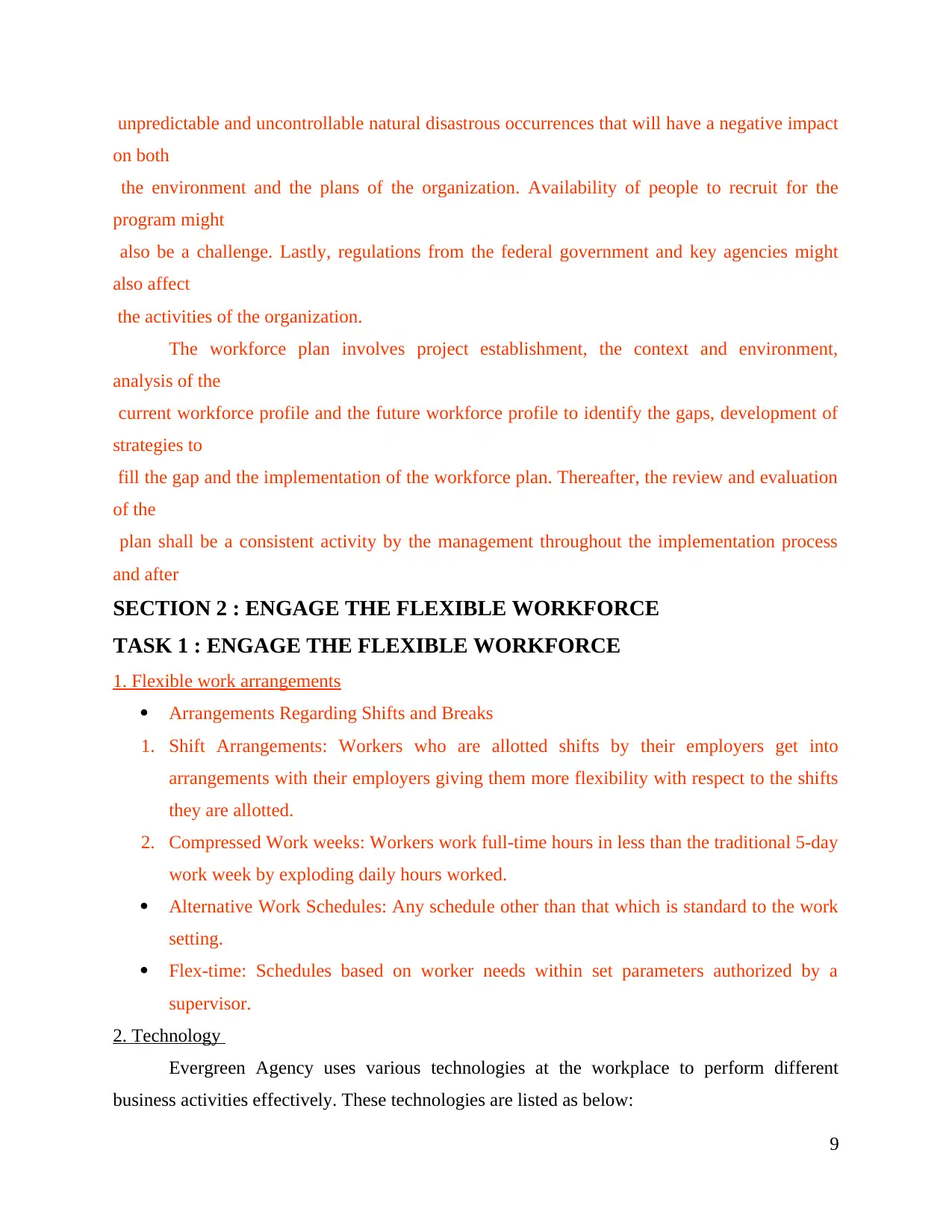
unpredictable and uncontrollable natural disastrous occurrences that will have a negative impact
on both
the environment and the plans of the organization. Availability of people to recruit for the
program might
also be a challenge. Lastly, regulations from the federal government and key agencies might
also affect
the activities of the organization.
The workforce plan involves project establishment, the context and environment,
analysis of the
current workforce profile and the future workforce profile to identify the gaps, development of
strategies to
fill the gap and the implementation of the workforce plan. Thereafter, the review and evaluation
of the
plan shall be a consistent activity by the management throughout the implementation process
and after
SECTION 2 : ENGAGE THE FLEXIBLE WORKFORCE
TASK 1 : ENGAGE THE FLEXIBLE WORKFORCE
1. Flexible work arrangements
Arrangements Regarding Shifts and Breaks
1. Shift Arrangements: Workers who are allotted shifts by their employers get into
arrangements with their employers giving them more flexibility with respect to the shifts
they are allotted.
2. Compressed Work weeks: Workers work full-time hours in less than the traditional 5-day
work week by exploding daily hours worked.
Alternative Work Schedules: Any schedule other than that which is standard to the work
setting.
Flex-time: Schedules based on worker needs within set parameters authorized by a
supervisor.
2. Technology
Evergreen Agency uses various technologies at the workplace to perform different
business activities effectively. These technologies are listed as below:
9
on both
the environment and the plans of the organization. Availability of people to recruit for the
program might
also be a challenge. Lastly, regulations from the federal government and key agencies might
also affect
the activities of the organization.
The workforce plan involves project establishment, the context and environment,
analysis of the
current workforce profile and the future workforce profile to identify the gaps, development of
strategies to
fill the gap and the implementation of the workforce plan. Thereafter, the review and evaluation
of the
plan shall be a consistent activity by the management throughout the implementation process
and after
SECTION 2 : ENGAGE THE FLEXIBLE WORKFORCE
TASK 1 : ENGAGE THE FLEXIBLE WORKFORCE
1. Flexible work arrangements
Arrangements Regarding Shifts and Breaks
1. Shift Arrangements: Workers who are allotted shifts by their employers get into
arrangements with their employers giving them more flexibility with respect to the shifts
they are allotted.
2. Compressed Work weeks: Workers work full-time hours in less than the traditional 5-day
work week by exploding daily hours worked.
Alternative Work Schedules: Any schedule other than that which is standard to the work
setting.
Flex-time: Schedules based on worker needs within set parameters authorized by a
supervisor.
2. Technology
Evergreen Agency uses various technologies at the workplace to perform different
business activities effectively. These technologies are listed as below:
9
Secure Best Marks with AI Grader
Need help grading? Try our AI Grader for instant feedback on your assignments.
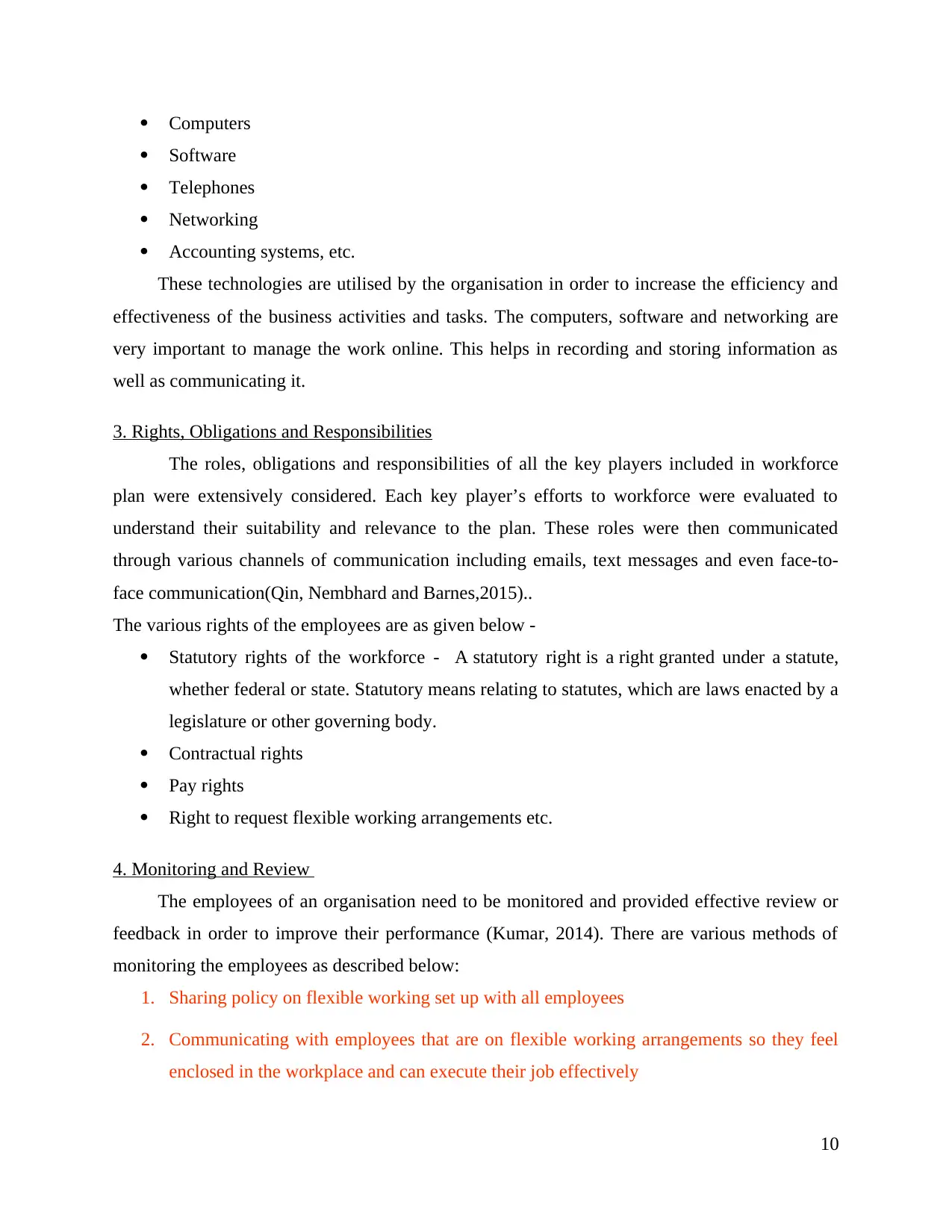
Computers
Software
Telephones
Networking
Accounting systems, etc.
These technologies are utilised by the organisation in order to increase the efficiency and
effectiveness of the business activities and tasks. The computers, software and networking are
very important to manage the work online. This helps in recording and storing information as
well as communicating it.
3. Rights, Obligations and Responsibilities
The roles, obligations and responsibilities of all the key players included in workforce
plan were extensively considered. Each key player’s efforts to workforce were evaluated to
understand their suitability and relevance to the plan. These roles were then communicated
through various channels of communication including emails, text messages and even face-to-
face communication(Qin, Nembhard and Barnes,2015)..
The various rights of the employees are as given below -
Statutory rights of the workforce - A statutory right is a right granted under a statute,
whether federal or state. Statutory means relating to statutes, which are laws enacted by a
legislature or other governing body.
Contractual rights
Pay rights
Right to request flexible working arrangements etc.
4. Monitoring and Review
The employees of an organisation need to be monitored and provided effective review or
feedback in order to improve their performance (Kumar, 2014). There are various methods of
monitoring the employees as described below:
1. Sharing policy on flexible working set up with all employees
2. Communicating with employees that are on flexible working arrangements so they feel
enclosed in the workplace and can execute their job effectively
10
Software
Telephones
Networking
Accounting systems, etc.
These technologies are utilised by the organisation in order to increase the efficiency and
effectiveness of the business activities and tasks. The computers, software and networking are
very important to manage the work online. This helps in recording and storing information as
well as communicating it.
3. Rights, Obligations and Responsibilities
The roles, obligations and responsibilities of all the key players included in workforce
plan were extensively considered. Each key player’s efforts to workforce were evaluated to
understand their suitability and relevance to the plan. These roles were then communicated
through various channels of communication including emails, text messages and even face-to-
face communication(Qin, Nembhard and Barnes,2015)..
The various rights of the employees are as given below -
Statutory rights of the workforce - A statutory right is a right granted under a statute,
whether federal or state. Statutory means relating to statutes, which are laws enacted by a
legislature or other governing body.
Contractual rights
Pay rights
Right to request flexible working arrangements etc.
4. Monitoring and Review
The employees of an organisation need to be monitored and provided effective review or
feedback in order to improve their performance (Kumar, 2014). There are various methods of
monitoring the employees as described below:
1. Sharing policy on flexible working set up with all employees
2. Communicating with employees that are on flexible working arrangements so they feel
enclosed in the workplace and can execute their job effectively
10
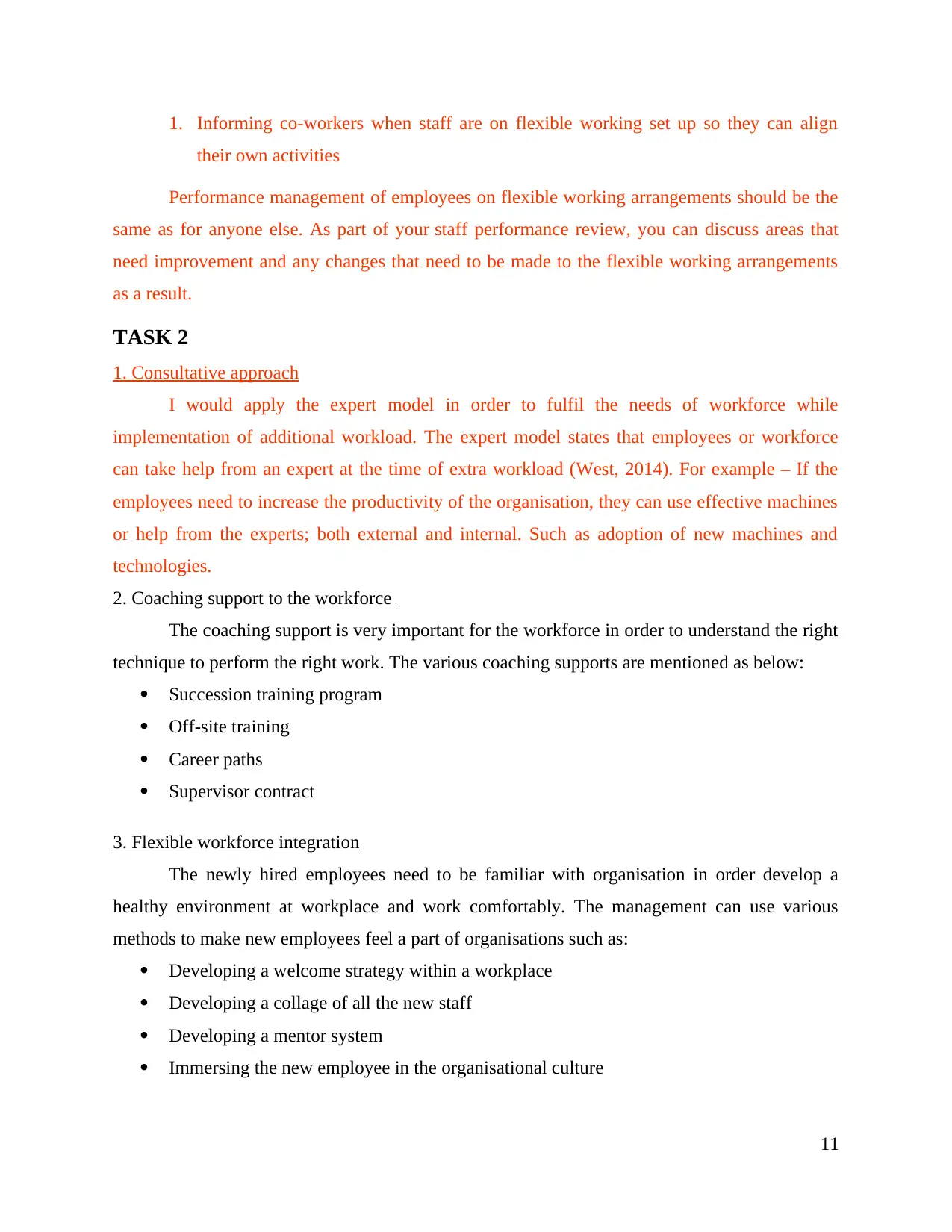
1. Informing co-workers when staff are on flexible working set up so they can align
their own activities
Performance management of employees on flexible working arrangements should be the
same as for anyone else. As part of your staff performance review, you can discuss areas that
need improvement and any changes that need to be made to the flexible working arrangements
as a result.
TASK 2
1. Consultative approach
I would apply the expert model in order to fulfil the needs of workforce while
implementation of additional workload. The expert model states that employees or workforce
can take help from an expert at the time of extra workload (West, 2014). For example – If the
employees need to increase the productivity of the organisation, they can use effective machines
or help from the experts; both external and internal. Such as adoption of new machines and
technologies.
2. Coaching support to the workforce
The coaching support is very important for the workforce in order to understand the right
technique to perform the right work. The various coaching supports are mentioned as below:
Succession training program
Off-site training
Career paths
Supervisor contract
3. Flexible workforce integration
The newly hired employees need to be familiar with organisation in order develop a
healthy environment at workplace and work comfortably. The management can use various
methods to make new employees feel a part of organisations such as:
Developing a welcome strategy within a workplace
Developing a collage of all the new staff
Developing a mentor system
Immersing the new employee in the organisational culture
11
their own activities
Performance management of employees on flexible working arrangements should be the
same as for anyone else. As part of your staff performance review, you can discuss areas that
need improvement and any changes that need to be made to the flexible working arrangements
as a result.
TASK 2
1. Consultative approach
I would apply the expert model in order to fulfil the needs of workforce while
implementation of additional workload. The expert model states that employees or workforce
can take help from an expert at the time of extra workload (West, 2014). For example – If the
employees need to increase the productivity of the organisation, they can use effective machines
or help from the experts; both external and internal. Such as adoption of new machines and
technologies.
2. Coaching support to the workforce
The coaching support is very important for the workforce in order to understand the right
technique to perform the right work. The various coaching supports are mentioned as below:
Succession training program
Off-site training
Career paths
Supervisor contract
3. Flexible workforce integration
The newly hired employees need to be familiar with organisation in order develop a
healthy environment at workplace and work comfortably. The management can use various
methods to make new employees feel a part of organisations such as:
Developing a welcome strategy within a workplace
Developing a collage of all the new staff
Developing a mentor system
Immersing the new employee in the organisational culture
11
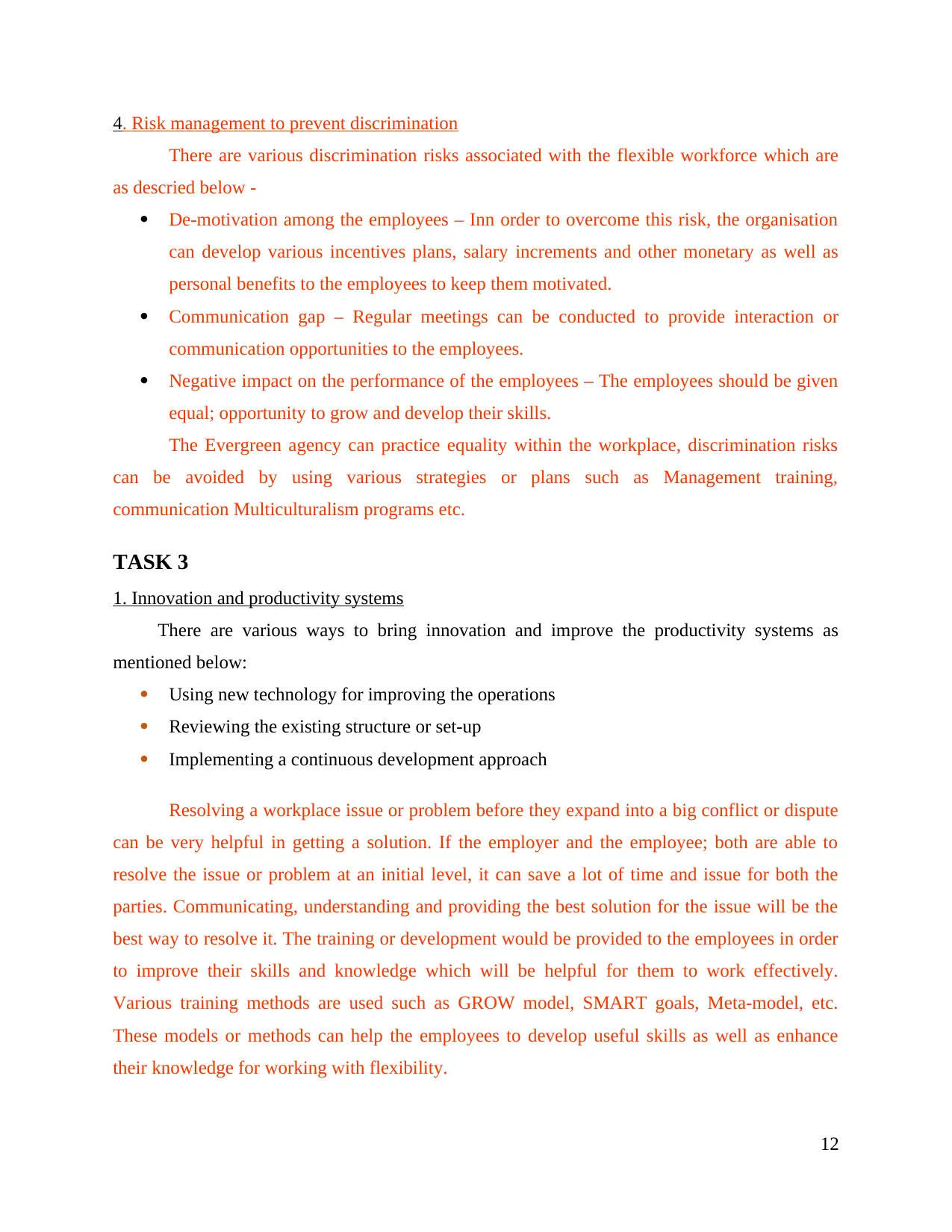
4. Risk management to prevent discrimination
There are various discrimination risks associated with the flexible workforce which are
as descried below -
De-motivation among the employees – Inn order to overcome this risk, the organisation
can develop various incentives plans, salary increments and other monetary as well as
personal benefits to the employees to keep them motivated.
Communication gap – Regular meetings can be conducted to provide interaction or
communication opportunities to the employees.
Negative impact on the performance of the employees – The employees should be given
equal; opportunity to grow and develop their skills.
The Evergreen agency can practice equality within the workplace, discrimination risks
can be avoided by using various strategies or plans such as Management training,
communication Multiculturalism programs etc.
TASK 3
1. Innovation and productivity systems
There are various ways to bring innovation and improve the productivity systems as
mentioned below:
Using new technology for improving the operations
Reviewing the existing structure or set-up
Implementing a continuous development approach
Resolving a workplace issue or problem before they expand into a big conflict or dispute
can be very helpful in getting a solution. If the employer and the employee; both are able to
resolve the issue or problem at an initial level, it can save a lot of time and issue for both the
parties. Communicating, understanding and providing the best solution for the issue will be the
best way to resolve it. The training or development would be provided to the employees in order
to improve their skills and knowledge which will be helpful for them to work effectively.
Various training methods are used such as GROW model, SMART goals, Meta-model, etc.
These models or methods can help the employees to develop useful skills as well as enhance
their knowledge for working with flexibility.
12
There are various discrimination risks associated with the flexible workforce which are
as descried below -
De-motivation among the employees – Inn order to overcome this risk, the organisation
can develop various incentives plans, salary increments and other monetary as well as
personal benefits to the employees to keep them motivated.
Communication gap – Regular meetings can be conducted to provide interaction or
communication opportunities to the employees.
Negative impact on the performance of the employees – The employees should be given
equal; opportunity to grow and develop their skills.
The Evergreen agency can practice equality within the workplace, discrimination risks
can be avoided by using various strategies or plans such as Management training,
communication Multiculturalism programs etc.
TASK 3
1. Innovation and productivity systems
There are various ways to bring innovation and improve the productivity systems as
mentioned below:
Using new technology for improving the operations
Reviewing the existing structure or set-up
Implementing a continuous development approach
Resolving a workplace issue or problem before they expand into a big conflict or dispute
can be very helpful in getting a solution. If the employer and the employee; both are able to
resolve the issue or problem at an initial level, it can save a lot of time and issue for both the
parties. Communicating, understanding and providing the best solution for the issue will be the
best way to resolve it. The training or development would be provided to the employees in order
to improve their skills and knowledge which will be helpful for them to work effectively.
Various training methods are used such as GROW model, SMART goals, Meta-model, etc.
These models or methods can help the employees to develop useful skills as well as enhance
their knowledge for working with flexibility.
12
Paraphrase This Document
Need a fresh take? Get an instant paraphrase of this document with our AI Paraphraser
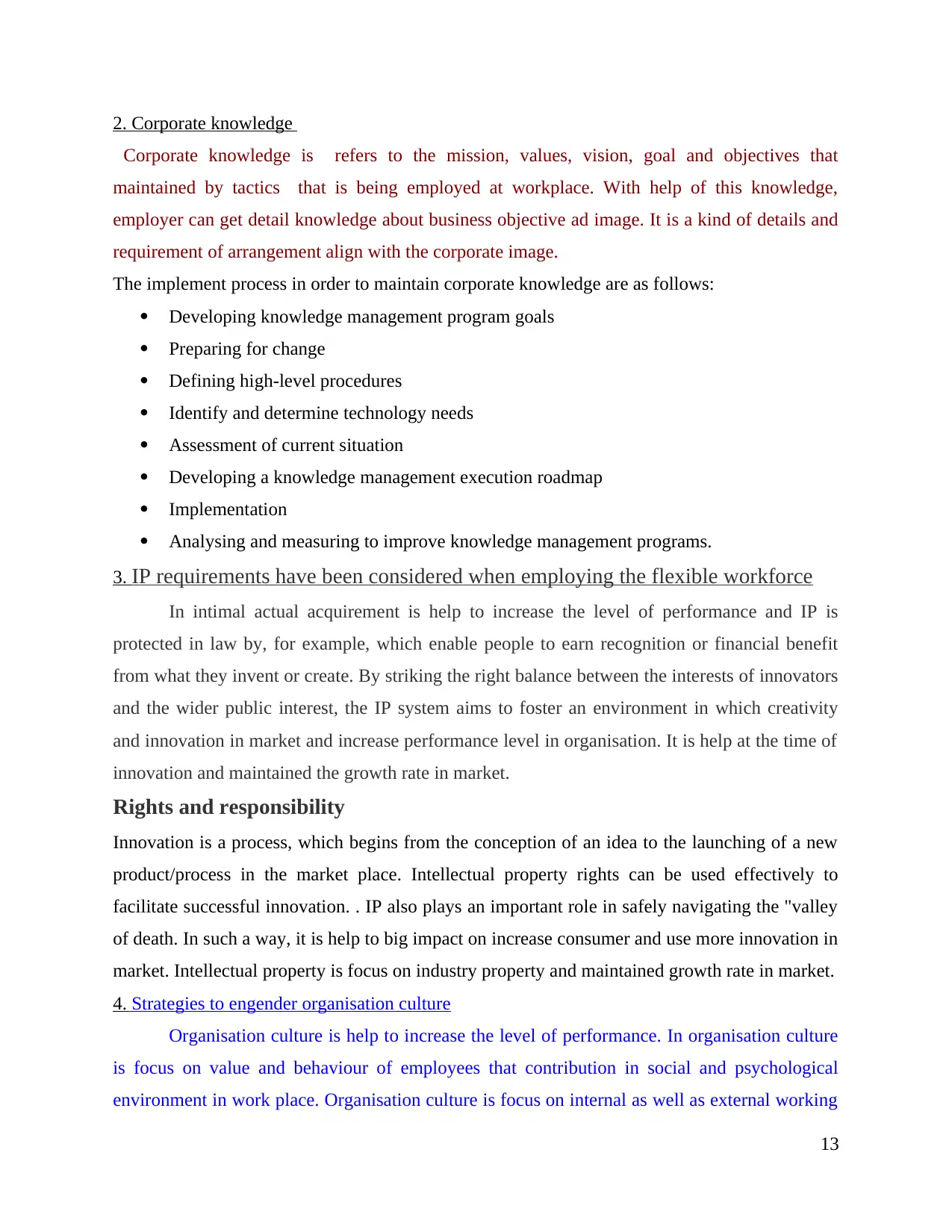
2. Corporate knowledge
Corporate knowledge is refers to the mission, values, vision, goal and objectives that
maintained by tactics that is being employed at workplace. With help of this knowledge,
employer can get detail knowledge about business objective ad image. It is a kind of details and
requirement of arrangement align with the corporate image.
The implement process in order to maintain corporate knowledge are as follows:
Developing knowledge management program goals
Preparing for change
Defining high-level procedures
Identify and determine technology needs
Assessment of current situation
Developing a knowledge management execution roadmap
Implementation
Analysing and measuring to improve knowledge management programs.
3. IP requirements have been considered when employing the flexible workforce
In intimal actual acquirement is help to increase the level of performance and IP is
protected in law by, for example, which enable people to earn recognition or financial benefit
from what they invent or create. By striking the right balance between the interests of innovators
and the wider public interest, the IP system aims to foster an environment in which creativity
and innovation in market and increase performance level in organisation. It is help at the time of
innovation and maintained the growth rate in market.
Rights and responsibility
Innovation is a process, which begins from the conception of an idea to the launching of a new
product/process in the market place. Intellectual property rights can be used effectively to
facilitate successful innovation. . IP also plays an important role in safely navigating the "valley
of death. In such a way, it is help to big impact on increase consumer and use more innovation in
market. Intellectual property is focus on industry property and maintained growth rate in market.
4. Strategies to engender organisation culture
Organisation culture is help to increase the level of performance. In organisation culture
is focus on value and behaviour of employees that contribution in social and psychological
environment in work place. Organisation culture is focus on internal as well as external working
13
Corporate knowledge is refers to the mission, values, vision, goal and objectives that
maintained by tactics that is being employed at workplace. With help of this knowledge,
employer can get detail knowledge about business objective ad image. It is a kind of details and
requirement of arrangement align with the corporate image.
The implement process in order to maintain corporate knowledge are as follows:
Developing knowledge management program goals
Preparing for change
Defining high-level procedures
Identify and determine technology needs
Assessment of current situation
Developing a knowledge management execution roadmap
Implementation
Analysing and measuring to improve knowledge management programs.
3. IP requirements have been considered when employing the flexible workforce
In intimal actual acquirement is help to increase the level of performance and IP is
protected in law by, for example, which enable people to earn recognition or financial benefit
from what they invent or create. By striking the right balance between the interests of innovators
and the wider public interest, the IP system aims to foster an environment in which creativity
and innovation in market and increase performance level in organisation. It is help at the time of
innovation and maintained the growth rate in market.
Rights and responsibility
Innovation is a process, which begins from the conception of an idea to the launching of a new
product/process in the market place. Intellectual property rights can be used effectively to
facilitate successful innovation. . IP also plays an important role in safely navigating the "valley
of death. In such a way, it is help to big impact on increase consumer and use more innovation in
market. Intellectual property is focus on industry property and maintained growth rate in market.
4. Strategies to engender organisation culture
Organisation culture is help to increase the level of performance. In organisation culture
is focus on value and behaviour of employees that contribution in social and psychological
environment in work place. Organisation culture is focus on internal as well as external working
13
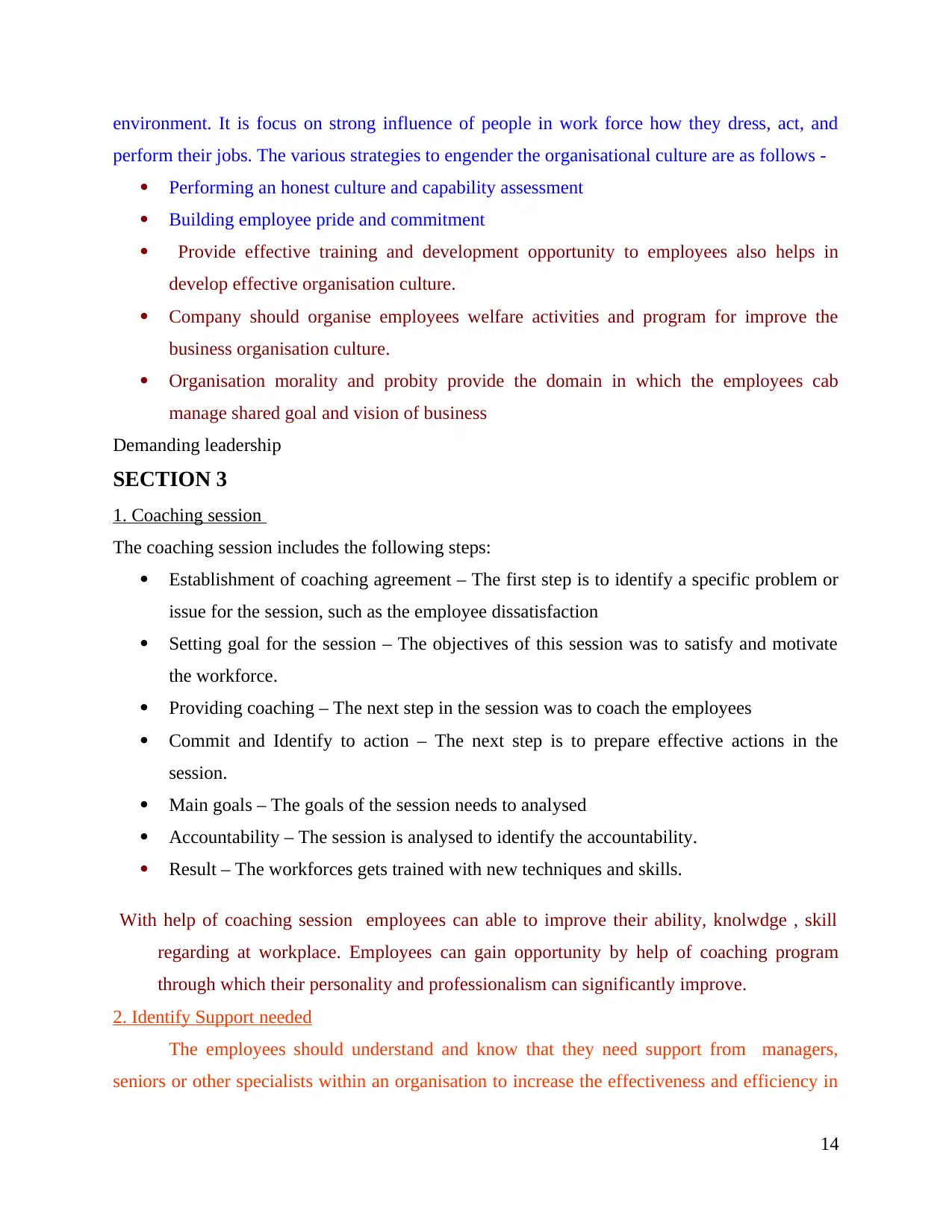
environment. It is focus on strong influence of people in work force how they dress, act, and
perform their jobs. The various strategies to engender the organisational culture are as follows -
Performing an honest culture and capability assessment
Building employee pride and commitment
Provide effective training and development opportunity to employees also helps in
develop effective organisation culture.
Company should organise employees welfare activities and program for improve the
business organisation culture.
Organisation morality and probity provide the domain in which the employees cab
manage shared goal and vision of business
Demanding leadership
SECTION 3
1. Coaching session
The coaching session includes the following steps:
Establishment of coaching agreement – The first step is to identify a specific problem or
issue for the session, such as the employee dissatisfaction
Setting goal for the session – The objectives of this session was to satisfy and motivate
the workforce.
Providing coaching – The next step in the session was to coach the employees
Commit and Identify to action – The next step is to prepare effective actions in the
session.
Main goals – The goals of the session needs to analysed
Accountability – The session is analysed to identify the accountability.
Result – The workforces gets trained with new techniques and skills.
With help of coaching session employees can able to improve their ability, knolwdge , skill
regarding at workplace. Employees can gain opportunity by help of coaching program
through which their personality and professionalism can significantly improve.
2. Identify Support needed
The employees should understand and know that they need support from managers,
seniors or other specialists within an organisation to increase the effectiveness and efficiency in
14
perform their jobs. The various strategies to engender the organisational culture are as follows -
Performing an honest culture and capability assessment
Building employee pride and commitment
Provide effective training and development opportunity to employees also helps in
develop effective organisation culture.
Company should organise employees welfare activities and program for improve the
business organisation culture.
Organisation morality and probity provide the domain in which the employees cab
manage shared goal and vision of business
Demanding leadership
SECTION 3
1. Coaching session
The coaching session includes the following steps:
Establishment of coaching agreement – The first step is to identify a specific problem or
issue for the session, such as the employee dissatisfaction
Setting goal for the session – The objectives of this session was to satisfy and motivate
the workforce.
Providing coaching – The next step in the session was to coach the employees
Commit and Identify to action – The next step is to prepare effective actions in the
session.
Main goals – The goals of the session needs to analysed
Accountability – The session is analysed to identify the accountability.
Result – The workforces gets trained with new techniques and skills.
With help of coaching session employees can able to improve their ability, knolwdge , skill
regarding at workplace. Employees can gain opportunity by help of coaching program
through which their personality and professionalism can significantly improve.
2. Identify Support needed
The employees should understand and know that they need support from managers,
seniors or other specialists within an organisation to increase the effectiveness and efficiency in
14
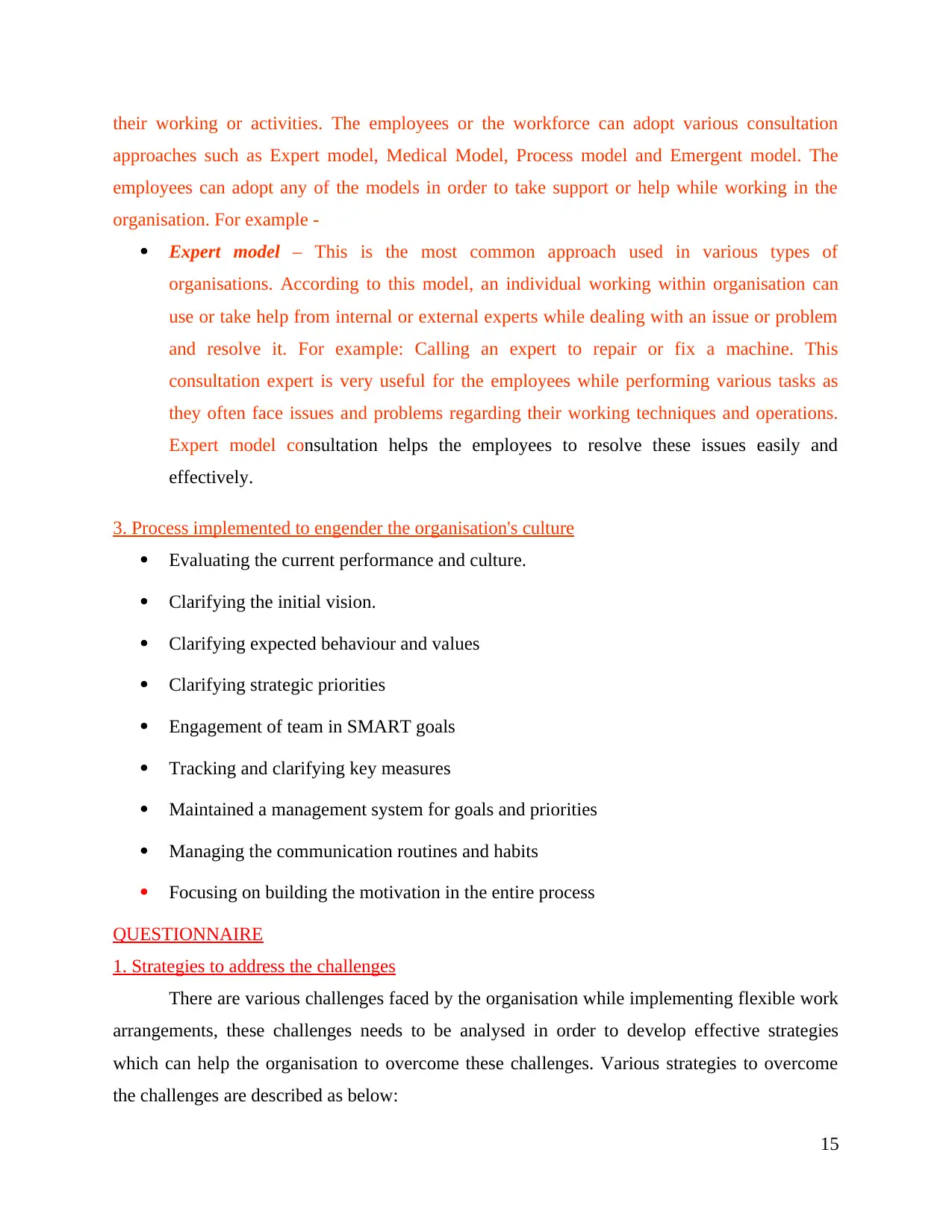
their working or activities. The employees or the workforce can adopt various consultation
approaches such as Expert model, Medical Model, Process model and Emergent model. The
employees can adopt any of the models in order to take support or help while working in the
organisation. For example -
Expert model – This is the most common approach used in various types of
organisations. According to this model, an individual working within organisation can
use or take help from internal or external experts while dealing with an issue or problem
and resolve it. For example: Calling an expert to repair or fix a machine. This
consultation expert is very useful for the employees while performing various tasks as
they often face issues and problems regarding their working techniques and operations.
Expert model consultation helps the employees to resolve these issues easily and
effectively.
3. Process implemented to engender the organisation's culture
Evaluating the current performance and culture.
Clarifying the initial vision.
Clarifying expected behaviour and values
Clarifying strategic priorities
Engagement of team in SMART goals
Tracking and clarifying key measures
Maintained a management system for goals and priorities
Managing the communication routines and habits
Focusing on building the motivation in the entire process
QUESTIONNAIRE
1. Strategies to address the challenges
There are various challenges faced by the organisation while implementing flexible work
arrangements, these challenges needs to be analysed in order to develop effective strategies
which can help the organisation to overcome these challenges. Various strategies to overcome
the challenges are described as below:
15
approaches such as Expert model, Medical Model, Process model and Emergent model. The
employees can adopt any of the models in order to take support or help while working in the
organisation. For example -
Expert model – This is the most common approach used in various types of
organisations. According to this model, an individual working within organisation can
use or take help from internal or external experts while dealing with an issue or problem
and resolve it. For example: Calling an expert to repair or fix a machine. This
consultation expert is very useful for the employees while performing various tasks as
they often face issues and problems regarding their working techniques and operations.
Expert model consultation helps the employees to resolve these issues easily and
effectively.
3. Process implemented to engender the organisation's culture
Evaluating the current performance and culture.
Clarifying the initial vision.
Clarifying expected behaviour and values
Clarifying strategic priorities
Engagement of team in SMART goals
Tracking and clarifying key measures
Maintained a management system for goals and priorities
Managing the communication routines and habits
Focusing on building the motivation in the entire process
QUESTIONNAIRE
1. Strategies to address the challenges
There are various challenges faced by the organisation while implementing flexible work
arrangements, these challenges needs to be analysed in order to develop effective strategies
which can help the organisation to overcome these challenges. Various strategies to overcome
the challenges are described as below:
15
Secure Best Marks with AI Grader
Need help grading? Try our AI Grader for instant feedback on your assignments.
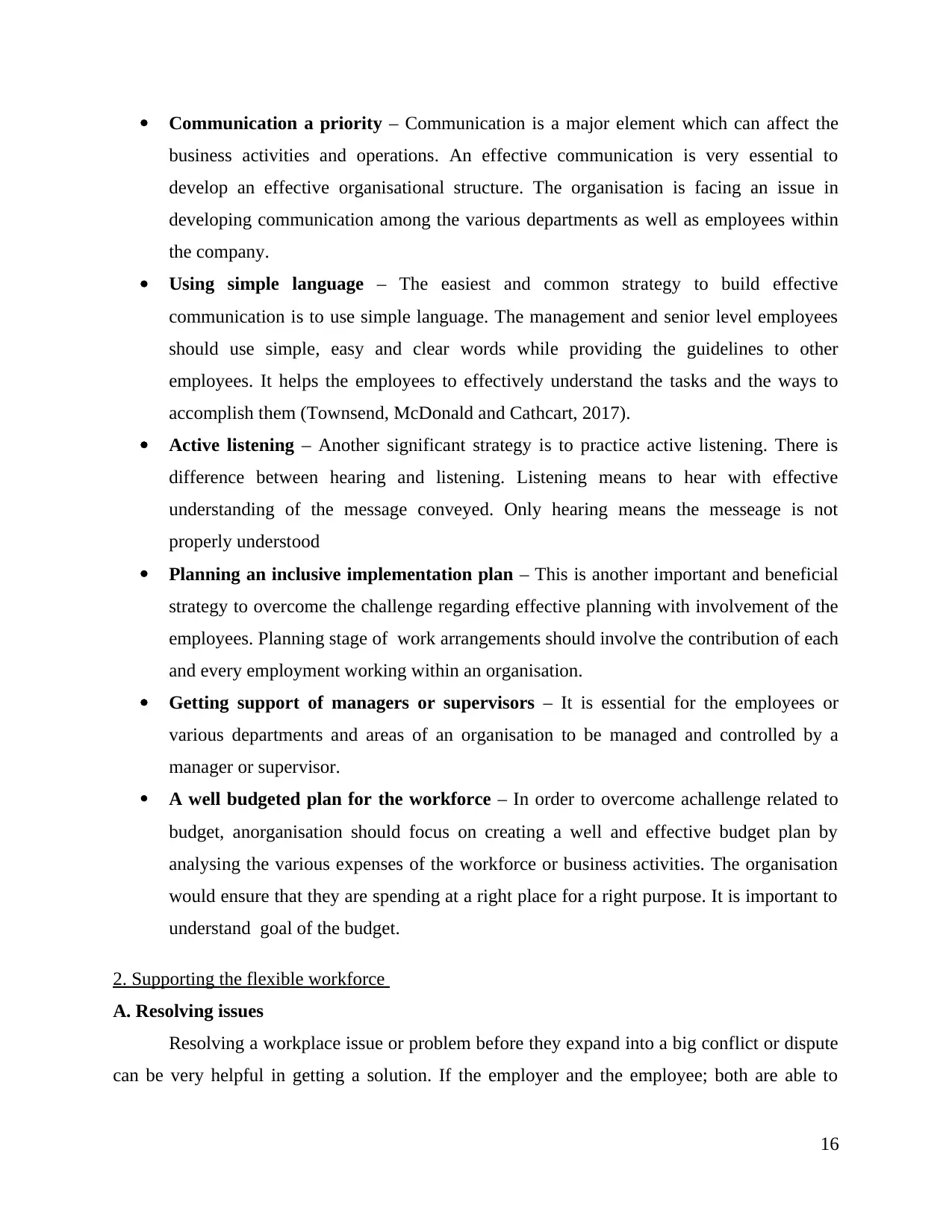
Communication a priority – Communication is a major element which can affect the
business activities and operations. An effective communication is very essential to
develop an effective organisational structure. The organisation is facing an issue in
developing communication among the various departments as well as employees within
the company.
Using simple language – The easiest and common strategy to build effective
communication is to use simple language. The management and senior level employees
should use simple, easy and clear words while providing the guidelines to other
employees. It helps the employees to effectively understand the tasks and the ways to
accomplish them (Townsend, McDonald and Cathcart, 2017).
Active listening – Another significant strategy is to practice active listening. There is
difference between hearing and listening. Listening means to hear with effective
understanding of the message conveyed. Only hearing means the messeage is not
properly understood
Planning an inclusive implementation plan – This is another important and beneficial
strategy to overcome the challenge regarding effective planning with involvement of the
employees. Planning stage of work arrangements should involve the contribution of each
and every employment working within an organisation.
Getting support of managers or supervisors – It is essential for the employees or
various departments and areas of an organisation to be managed and controlled by a
manager or supervisor.
A well budgeted plan for the workforce – In order to overcome achallenge related to
budget, anorganisation should focus on creating a well and effective budget plan by
analysing the various expenses of the workforce or business activities. The organisation
would ensure that they are spending at a right place for a right purpose. It is important to
understand goal of the budget.
2. Supporting the flexible workforce
A. Resolving issues
Resolving a workplace issue or problem before they expand into a big conflict or dispute
can be very helpful in getting a solution. If the employer and the employee; both are able to
16
business activities and operations. An effective communication is very essential to
develop an effective organisational structure. The organisation is facing an issue in
developing communication among the various departments as well as employees within
the company.
Using simple language – The easiest and common strategy to build effective
communication is to use simple language. The management and senior level employees
should use simple, easy and clear words while providing the guidelines to other
employees. It helps the employees to effectively understand the tasks and the ways to
accomplish them (Townsend, McDonald and Cathcart, 2017).
Active listening – Another significant strategy is to practice active listening. There is
difference between hearing and listening. Listening means to hear with effective
understanding of the message conveyed. Only hearing means the messeage is not
properly understood
Planning an inclusive implementation plan – This is another important and beneficial
strategy to overcome the challenge regarding effective planning with involvement of the
employees. Planning stage of work arrangements should involve the contribution of each
and every employment working within an organisation.
Getting support of managers or supervisors – It is essential for the employees or
various departments and areas of an organisation to be managed and controlled by a
manager or supervisor.
A well budgeted plan for the workforce – In order to overcome achallenge related to
budget, anorganisation should focus on creating a well and effective budget plan by
analysing the various expenses of the workforce or business activities. The organisation
would ensure that they are spending at a right place for a right purpose. It is important to
understand goal of the budget.
2. Supporting the flexible workforce
A. Resolving issues
Resolving a workplace issue or problem before they expand into a big conflict or dispute
can be very helpful in getting a solution. If the employer and the employee; both are able to
16
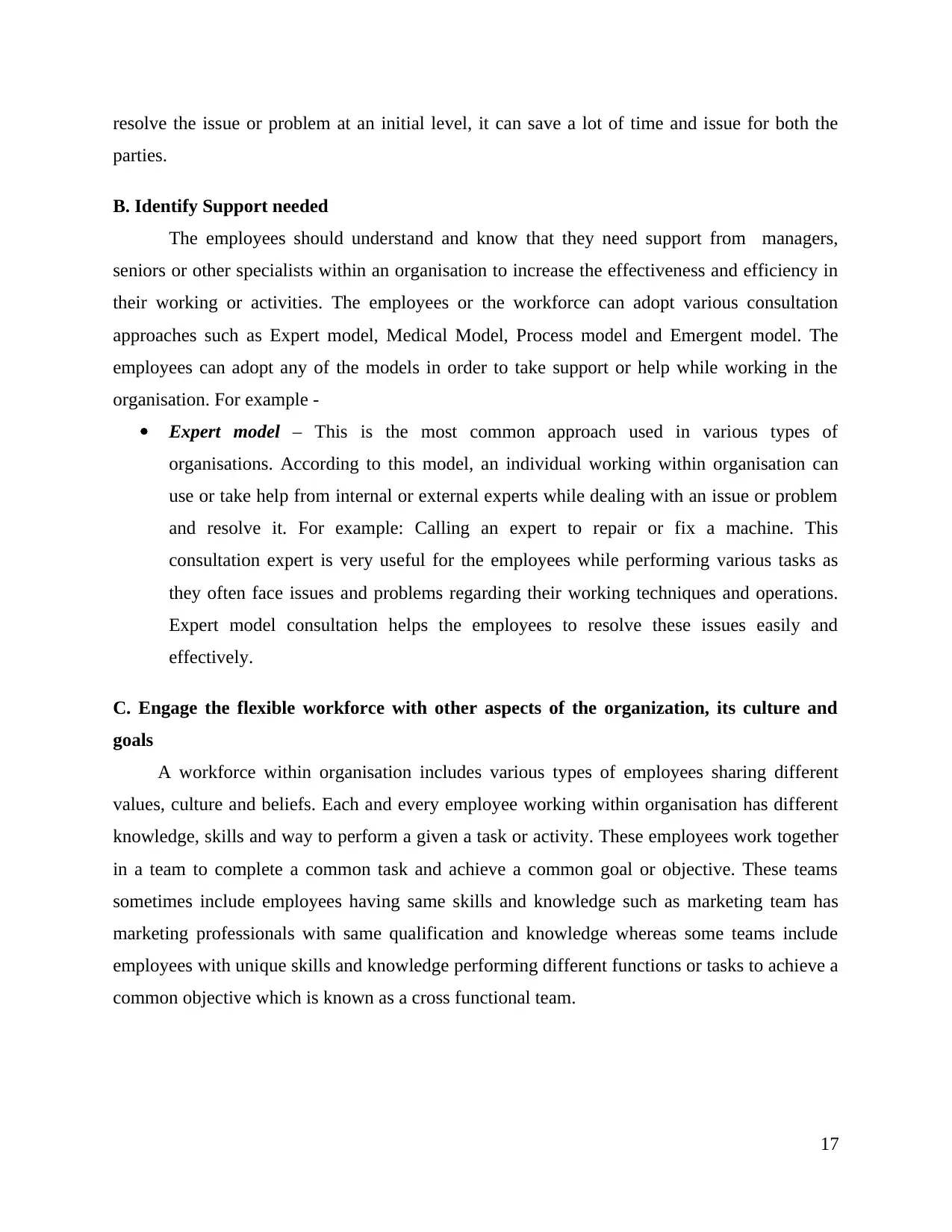
resolve the issue or problem at an initial level, it can save a lot of time and issue for both the
parties.
B. Identify Support needed
The employees should understand and know that they need support from managers,
seniors or other specialists within an organisation to increase the effectiveness and efficiency in
their working or activities. The employees or the workforce can adopt various consultation
approaches such as Expert model, Medical Model, Process model and Emergent model. The
employees can adopt any of the models in order to take support or help while working in the
organisation. For example -
Expert model – This is the most common approach used in various types of
organisations. According to this model, an individual working within organisation can
use or take help from internal or external experts while dealing with an issue or problem
and resolve it. For example: Calling an expert to repair or fix a machine. This
consultation expert is very useful for the employees while performing various tasks as
they often face issues and problems regarding their working techniques and operations.
Expert model consultation helps the employees to resolve these issues easily and
effectively.
C. Engage the flexible workforce with other aspects of the organization, its culture and
goals
A workforce within organisation includes various types of employees sharing different
values, culture and beliefs. Each and every employee working within organisation has different
knowledge, skills and way to perform a given a task or activity. These employees work together
in a team to complete a common task and achieve a common goal or objective. These teams
sometimes include employees having same skills and knowledge such as marketing team has
marketing professionals with same qualification and knowledge whereas some teams include
employees with unique skills and knowledge performing different functions or tasks to achieve a
common objective which is known as a cross functional team.
17
parties.
B. Identify Support needed
The employees should understand and know that they need support from managers,
seniors or other specialists within an organisation to increase the effectiveness and efficiency in
their working or activities. The employees or the workforce can adopt various consultation
approaches such as Expert model, Medical Model, Process model and Emergent model. The
employees can adopt any of the models in order to take support or help while working in the
organisation. For example -
Expert model – This is the most common approach used in various types of
organisations. According to this model, an individual working within organisation can
use or take help from internal or external experts while dealing with an issue or problem
and resolve it. For example: Calling an expert to repair or fix a machine. This
consultation expert is very useful for the employees while performing various tasks as
they often face issues and problems regarding their working techniques and operations.
Expert model consultation helps the employees to resolve these issues easily and
effectively.
C. Engage the flexible workforce with other aspects of the organization, its culture and
goals
A workforce within organisation includes various types of employees sharing different
values, culture and beliefs. Each and every employee working within organisation has different
knowledge, skills and way to perform a given a task or activity. These employees work together
in a team to complete a common task and achieve a common goal or objective. These teams
sometimes include employees having same skills and knowledge such as marketing team has
marketing professionals with same qualification and knowledge whereas some teams include
employees with unique skills and knowledge performing different functions or tasks to achieve a
common objective which is known as a cross functional team.
17
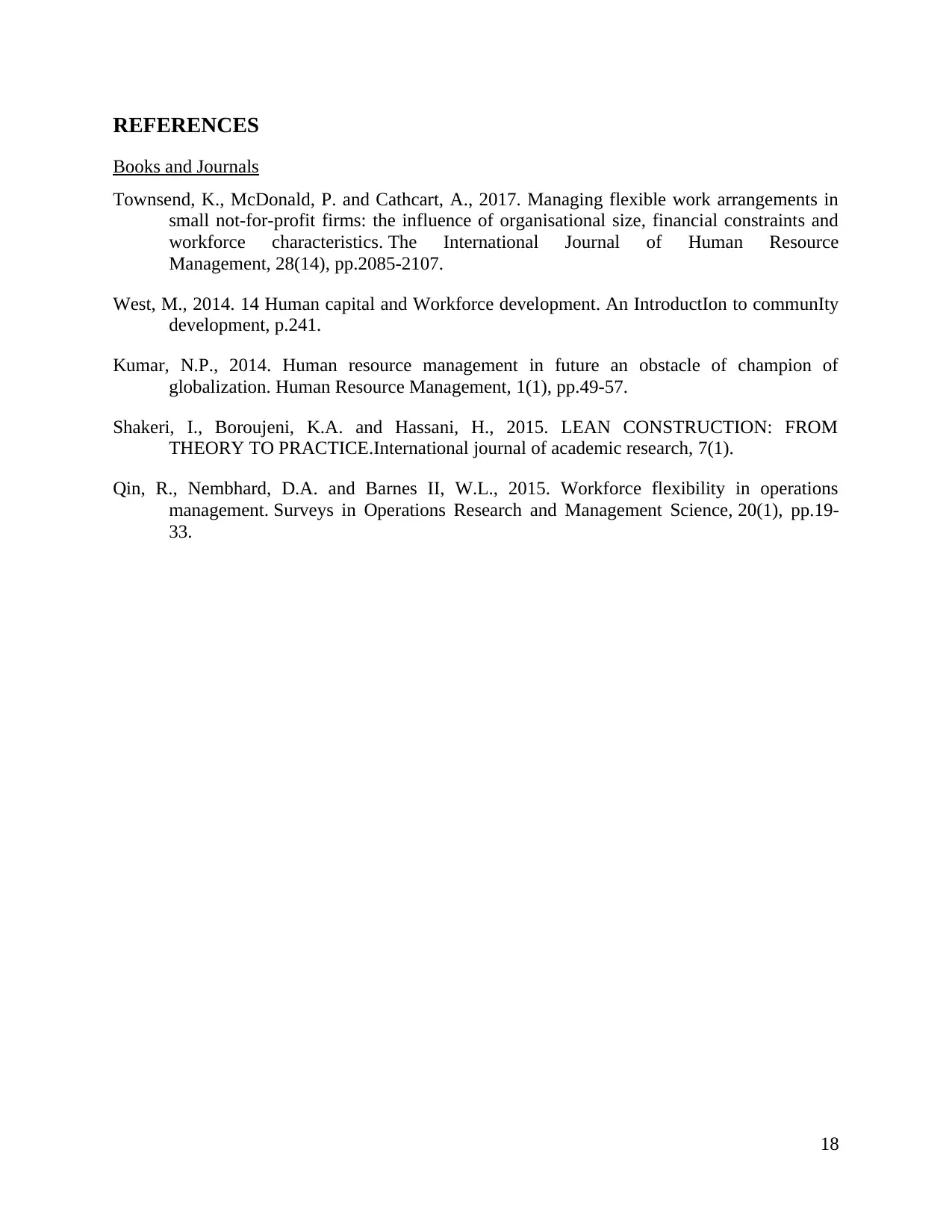
REFERENCES
Books and Journals
Townsend, K., McDonald, P. and Cathcart, A., 2017. Managing flexible work arrangements in
small not-for-profit firms: the influence of organisational size, financial constraints and
workforce characteristics. The International Journal of Human Resource
Management, 28(14), pp.2085-2107.
West, M., 2014. 14 Human capital and Workforce development. An IntroductIon to communIty
development, p.241.
Kumar, N.P., 2014. Human resource management in future an obstacle of champion of
globalization. Human Resource Management, 1(1), pp.49-57.
Shakeri, I., Boroujeni, K.A. and Hassani, H., 2015. LEAN CONSTRUCTION: FROM
THEORY TO PRACTICE.International journal of academic research, 7(1).
Qin, R., Nembhard, D.A. and Barnes II, W.L., 2015. Workforce flexibility in operations
management. Surveys in Operations Research and Management Science, 20(1), pp.19-
33.
18
Books and Journals
Townsend, K., McDonald, P. and Cathcart, A., 2017. Managing flexible work arrangements in
small not-for-profit firms: the influence of organisational size, financial constraints and
workforce characteristics. The International Journal of Human Resource
Management, 28(14), pp.2085-2107.
West, M., 2014. 14 Human capital and Workforce development. An IntroductIon to communIty
development, p.241.
Kumar, N.P., 2014. Human resource management in future an obstacle of champion of
globalization. Human Resource Management, 1(1), pp.49-57.
Shakeri, I., Boroujeni, K.A. and Hassani, H., 2015. LEAN CONSTRUCTION: FROM
THEORY TO PRACTICE.International journal of academic research, 7(1).
Qin, R., Nembhard, D.A. and Barnes II, W.L., 2015. Workforce flexibility in operations
management. Surveys in Operations Research and Management Science, 20(1), pp.19-
33.
18
1 out of 19
Related Documents
Your All-in-One AI-Powered Toolkit for Academic Success.
+13062052269
info@desklib.com
Available 24*7 on WhatsApp / Email
![[object Object]](/_next/static/media/star-bottom.7253800d.svg)
Unlock your academic potential
© 2024 | Zucol Services PVT LTD | All rights reserved.





